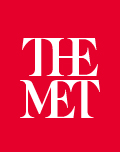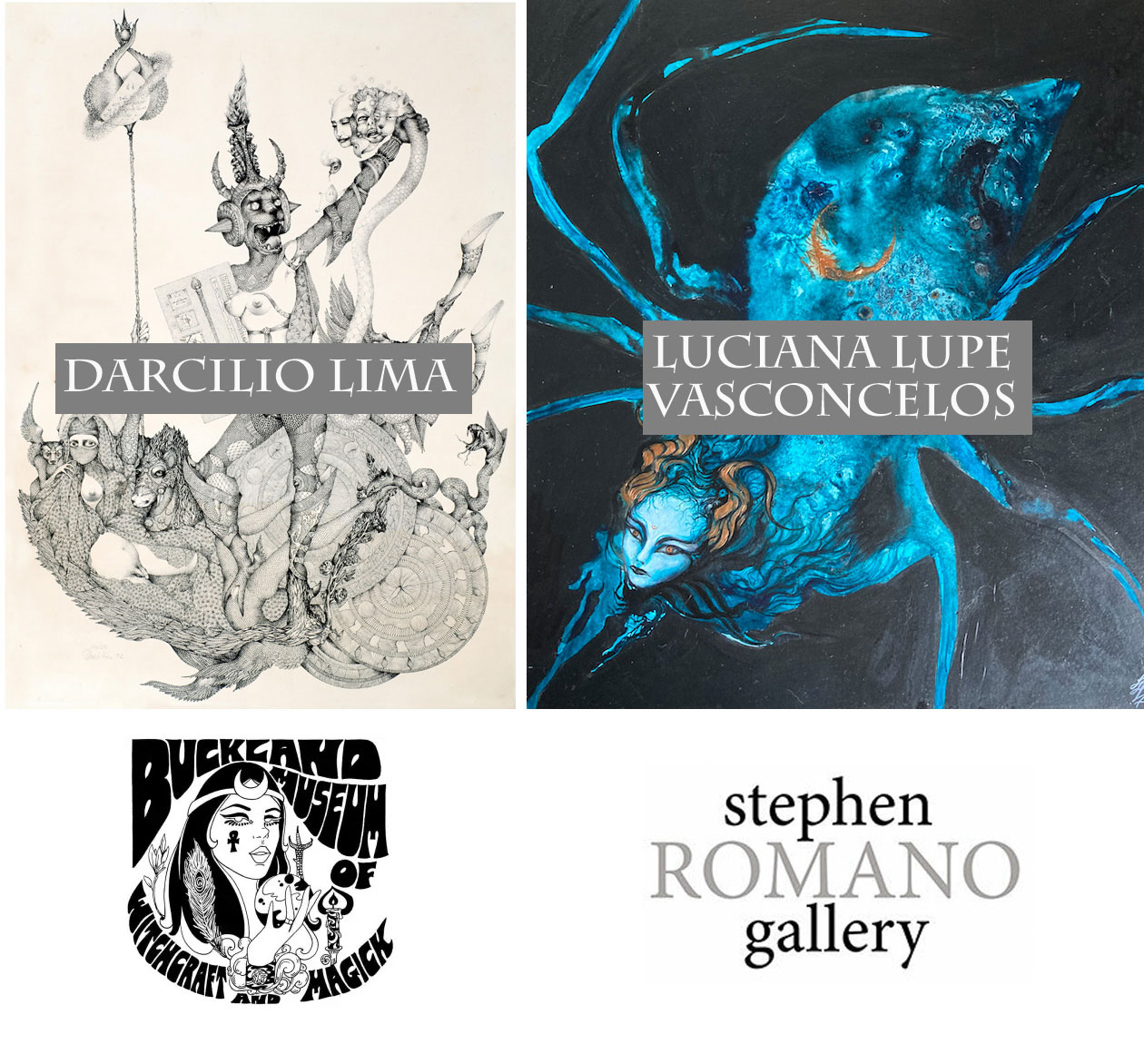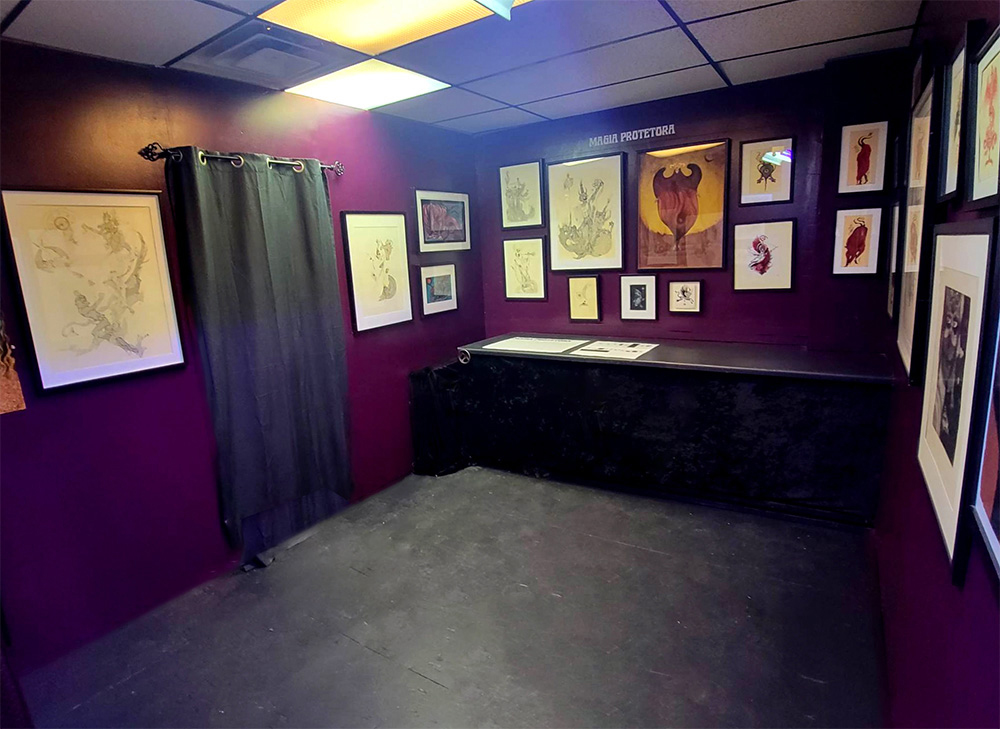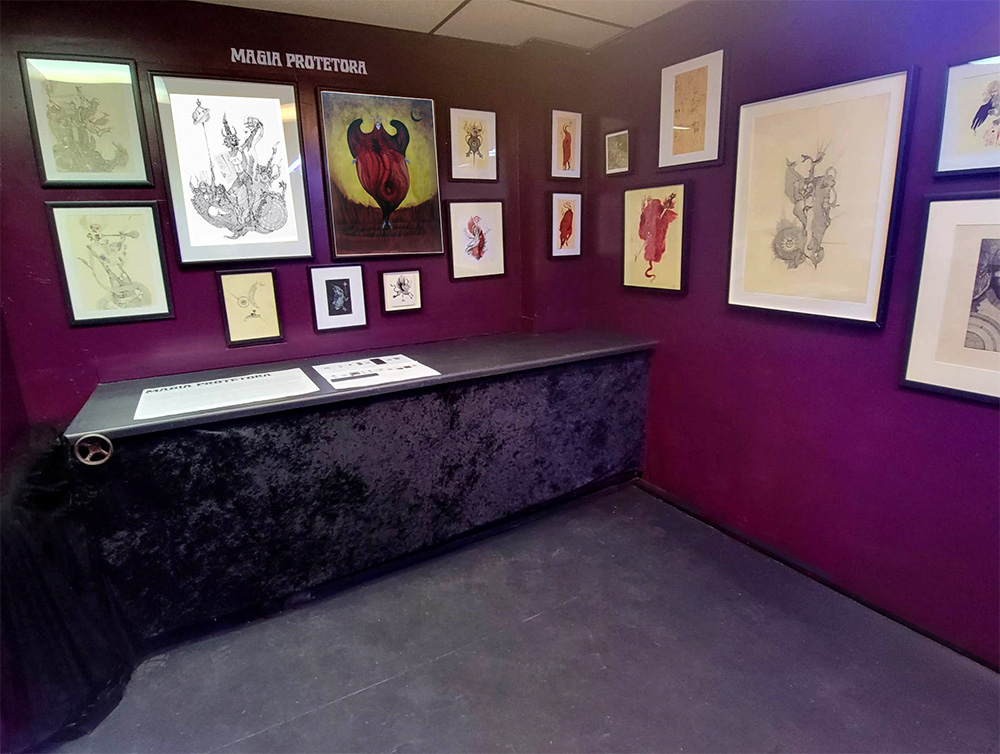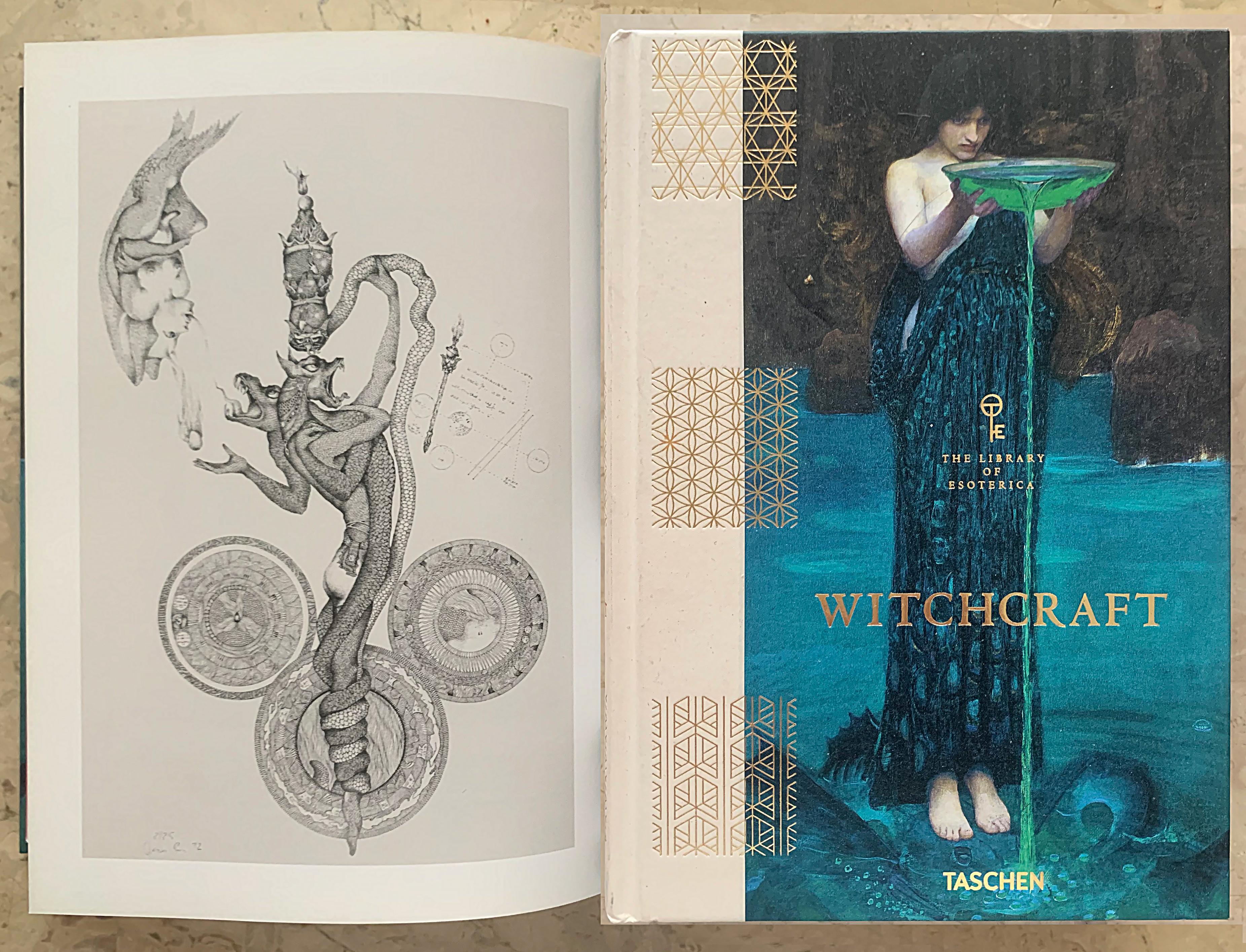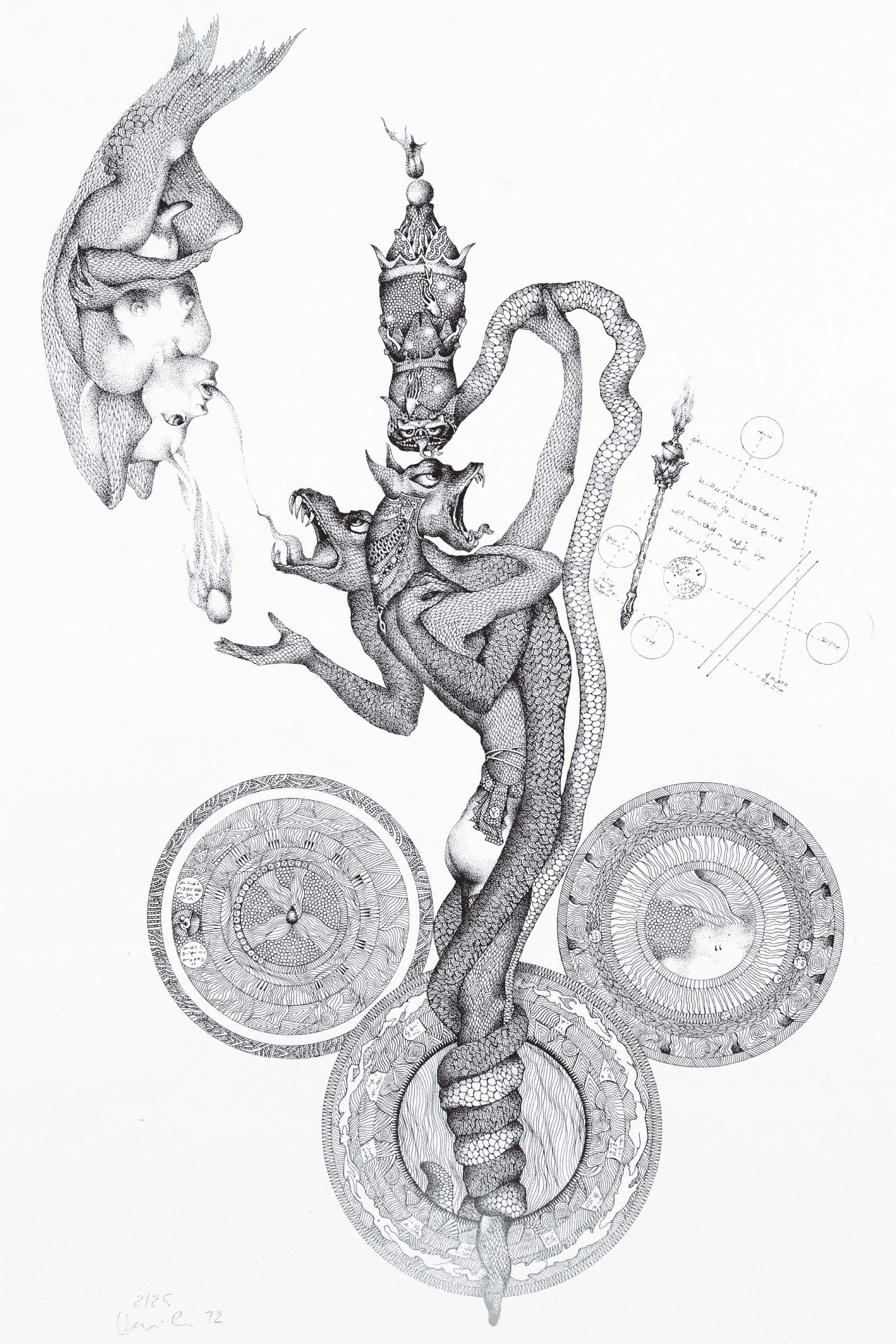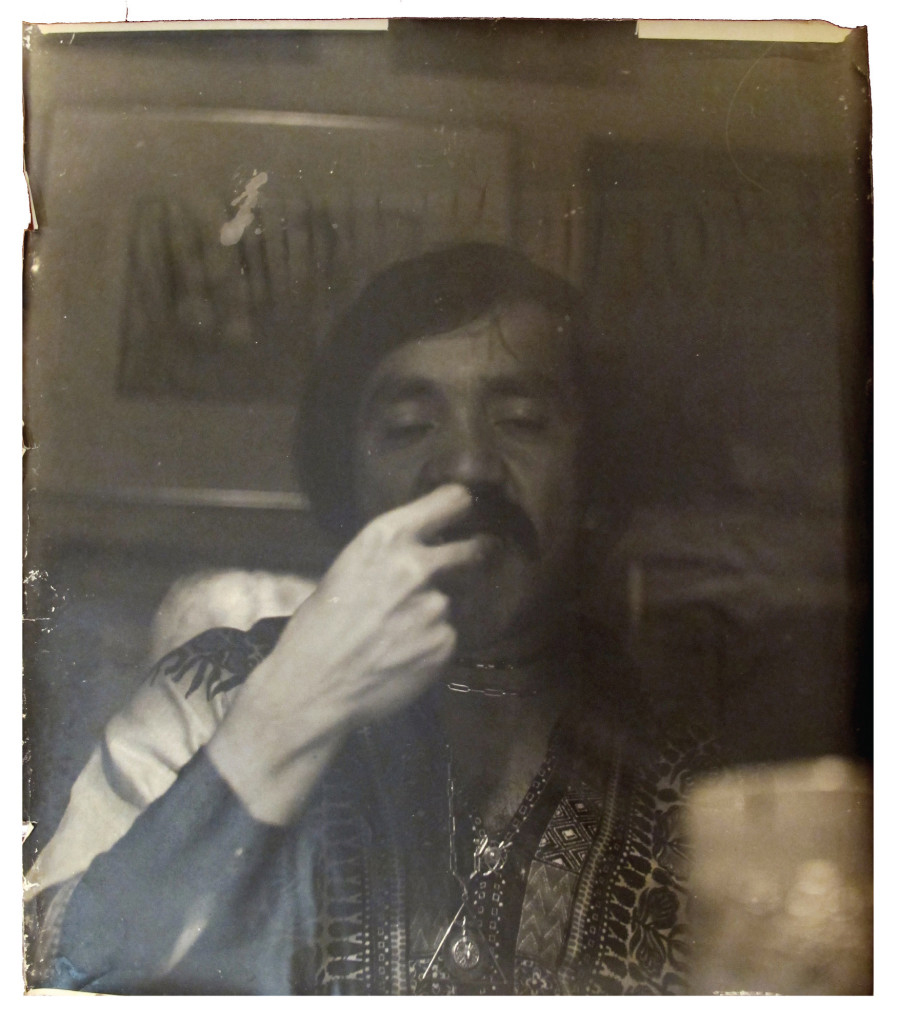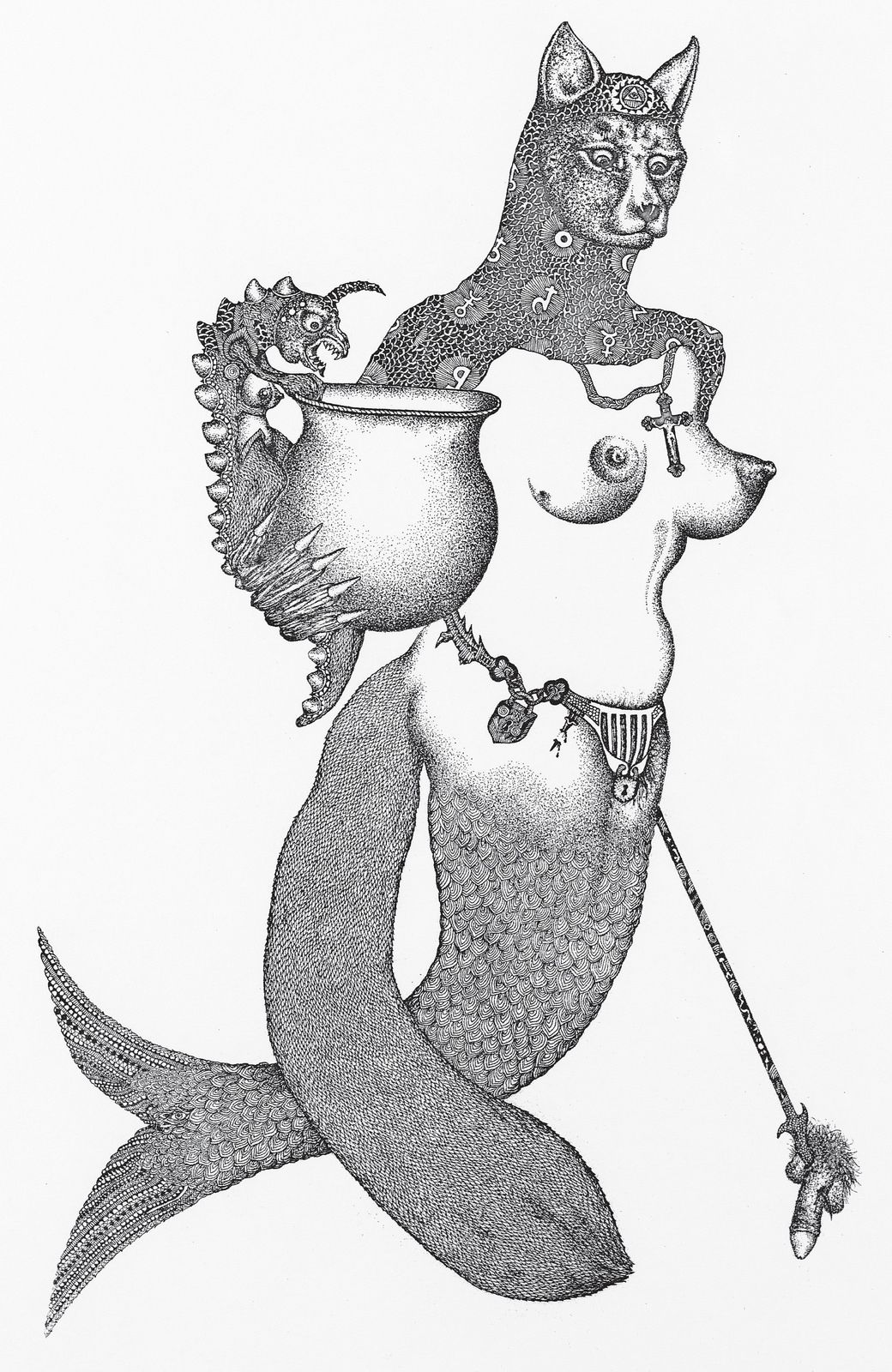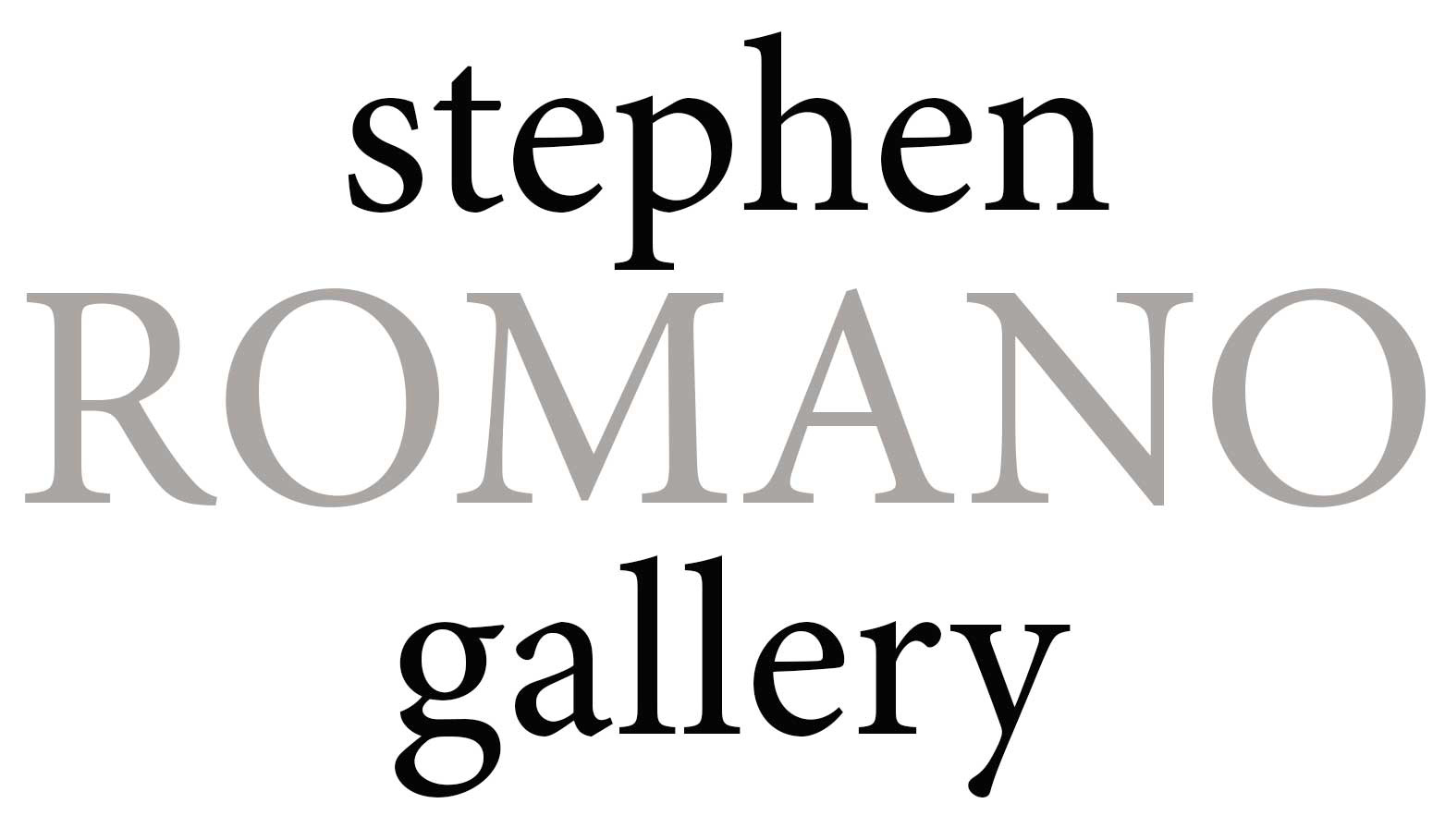
Darcilio Lima at the Outsider Art Fair, with Charles Dellschau, Henry Darger, Martin Ramirez, Judith Scott, Bill Traylor, William Blayney
at Stephen Romano Gallery booth. courtesy Stephen Romano Gallery

Darcilio Lima at The Metro Show New York with Hermon Finney (1929 - 2008) and Andreas Cellarius (c. 1596, – 1665) .
courtesy Stephen Romano Gallery
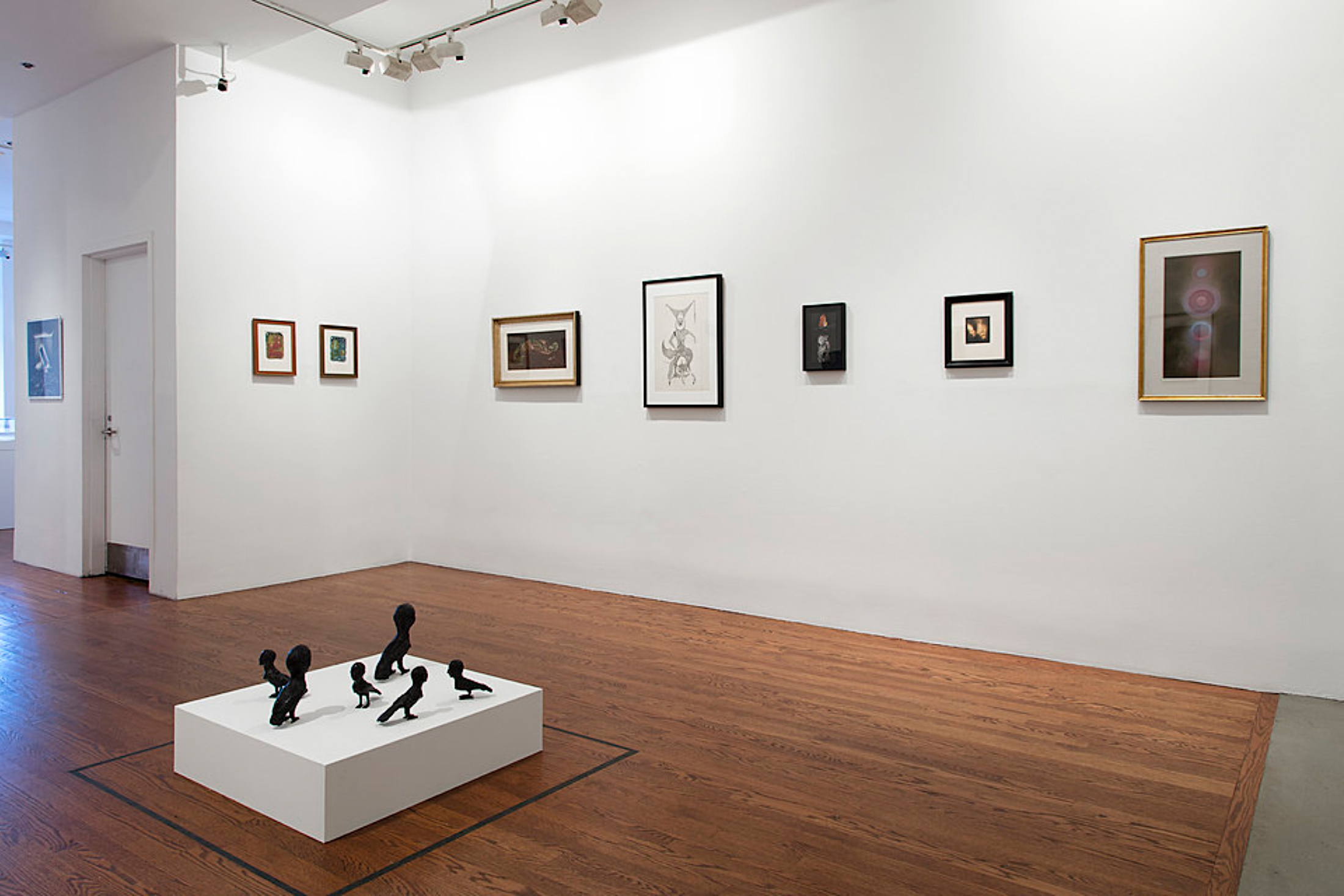
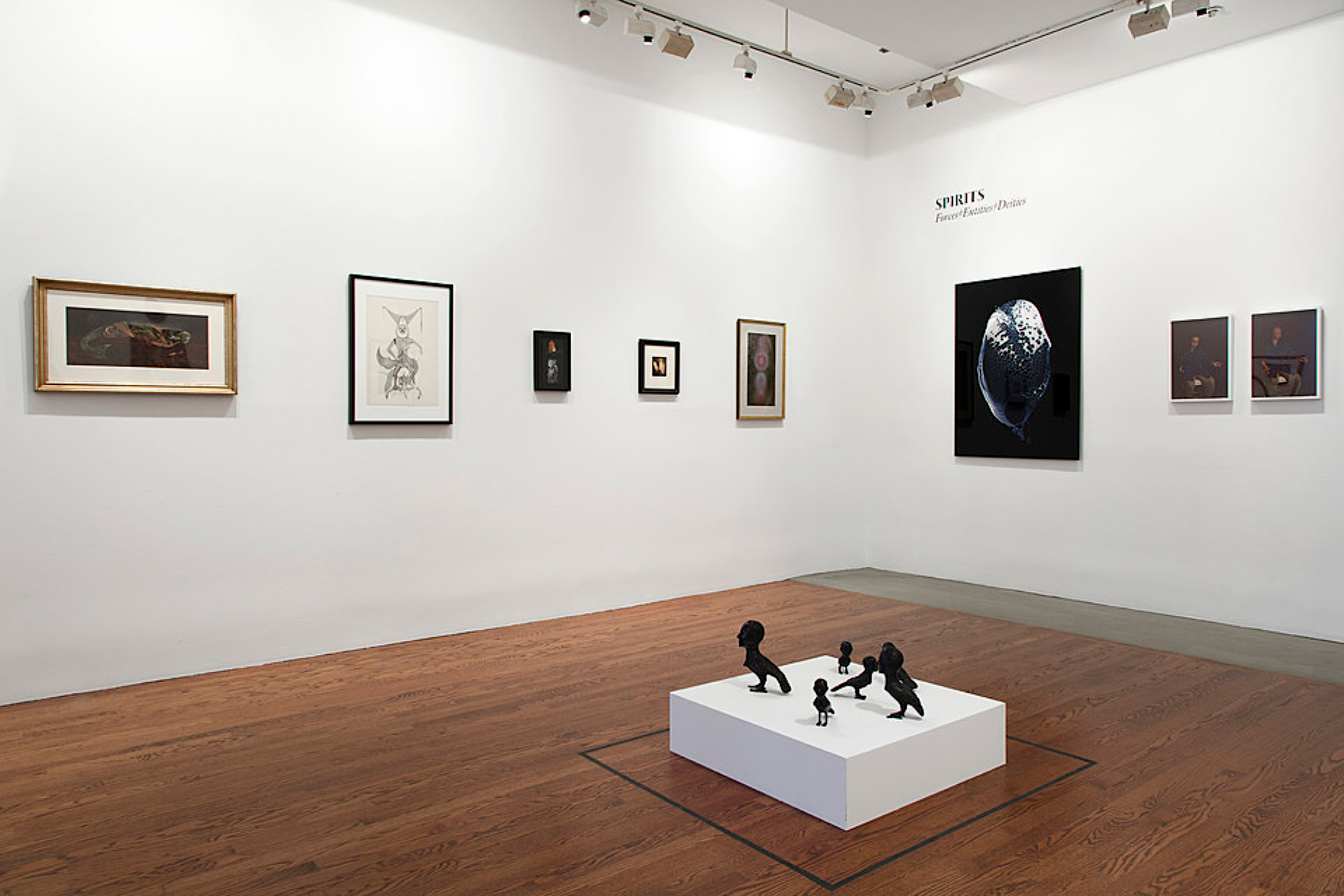
curated by Pam Grossman 2016 at 80WSE gallery NYC.
With Kiki Smith (forground).
courtesy Stephen Romano Gallery
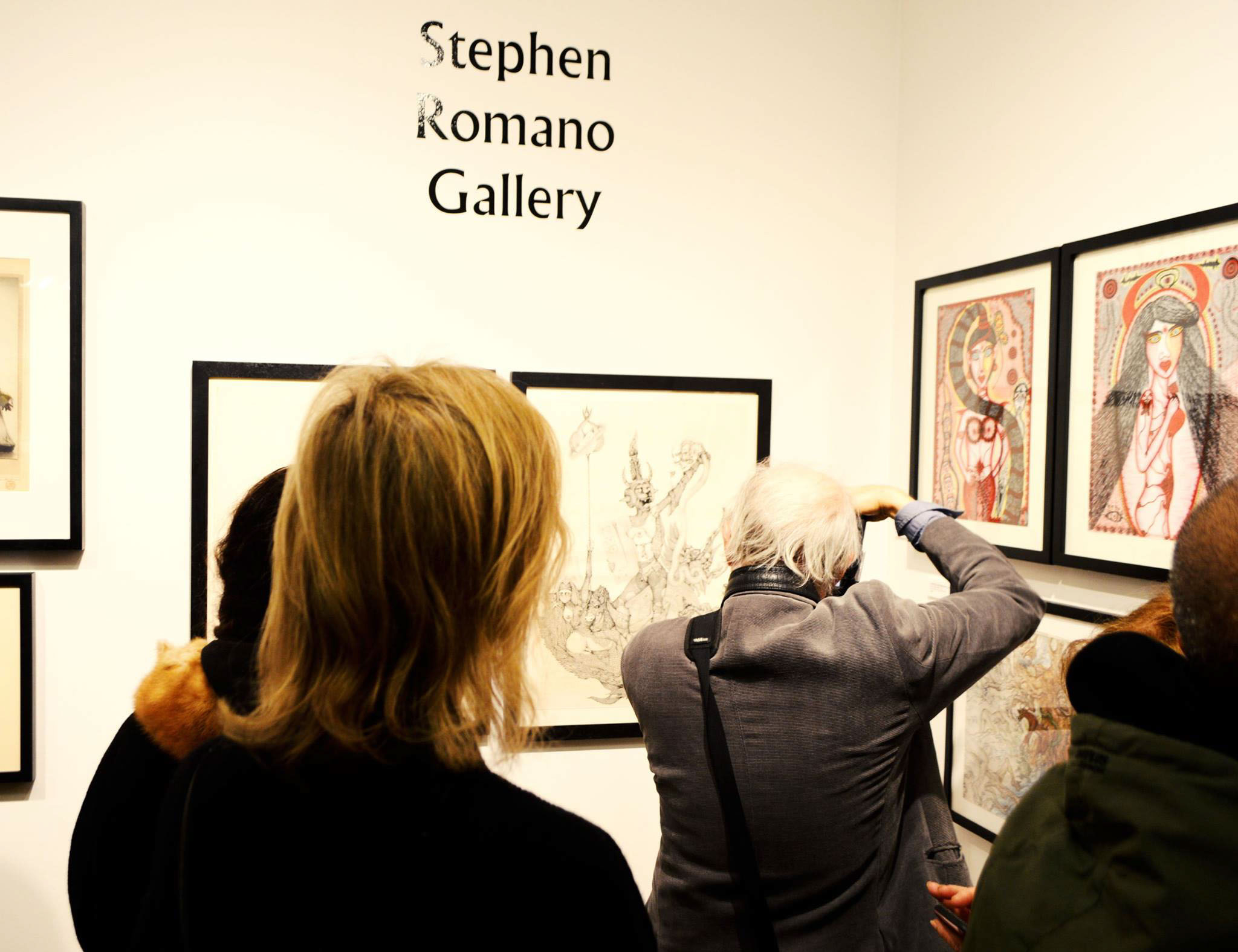
The art of darcilio Lima at The Outsider Art Fair in New York.
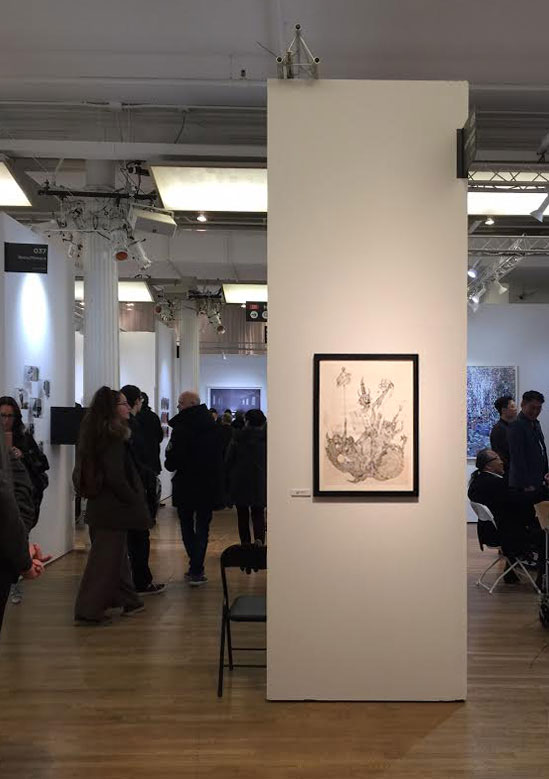
The art of darcilio Lima at SCOPE Art Fair in New York 2019.
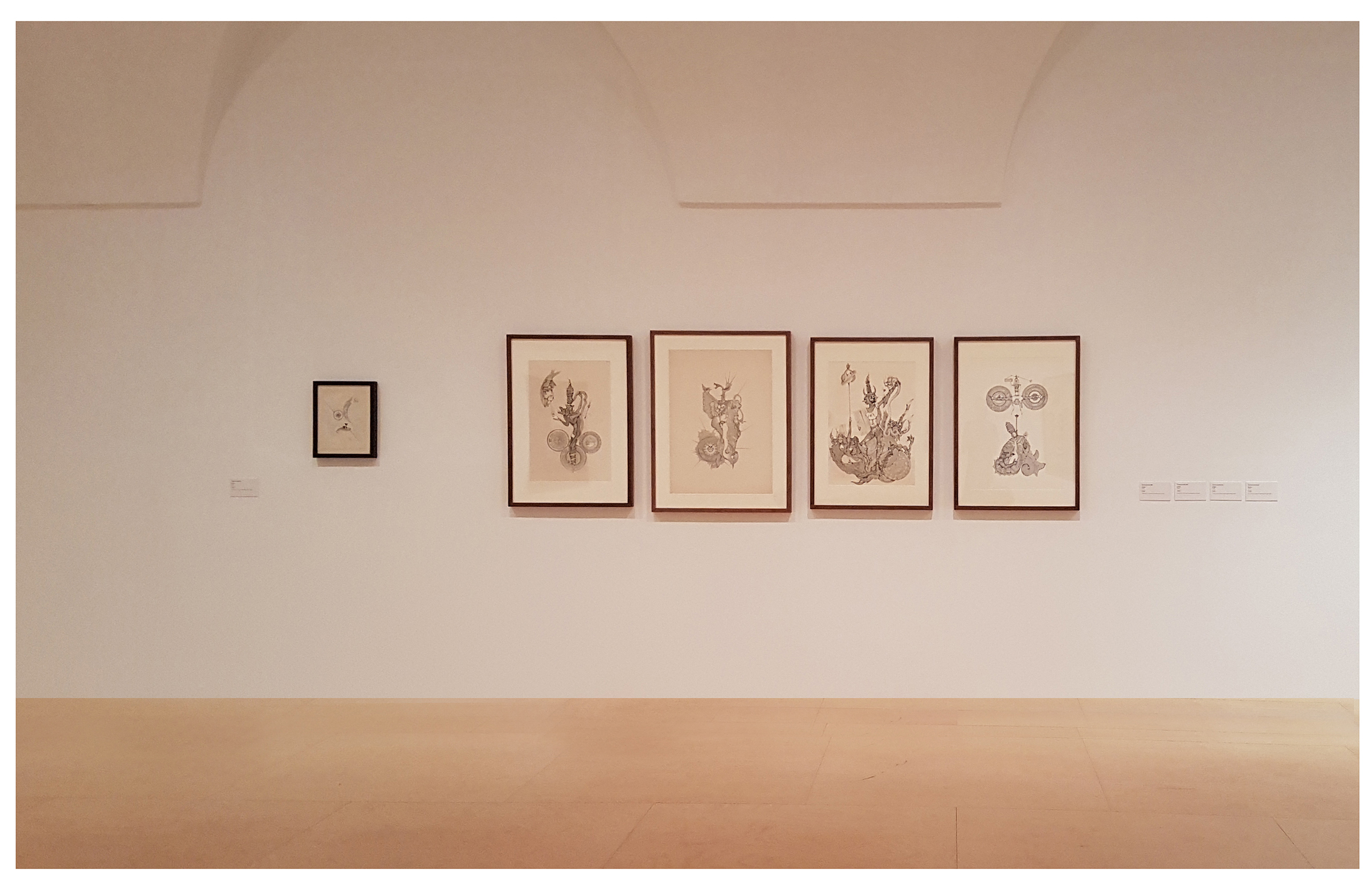
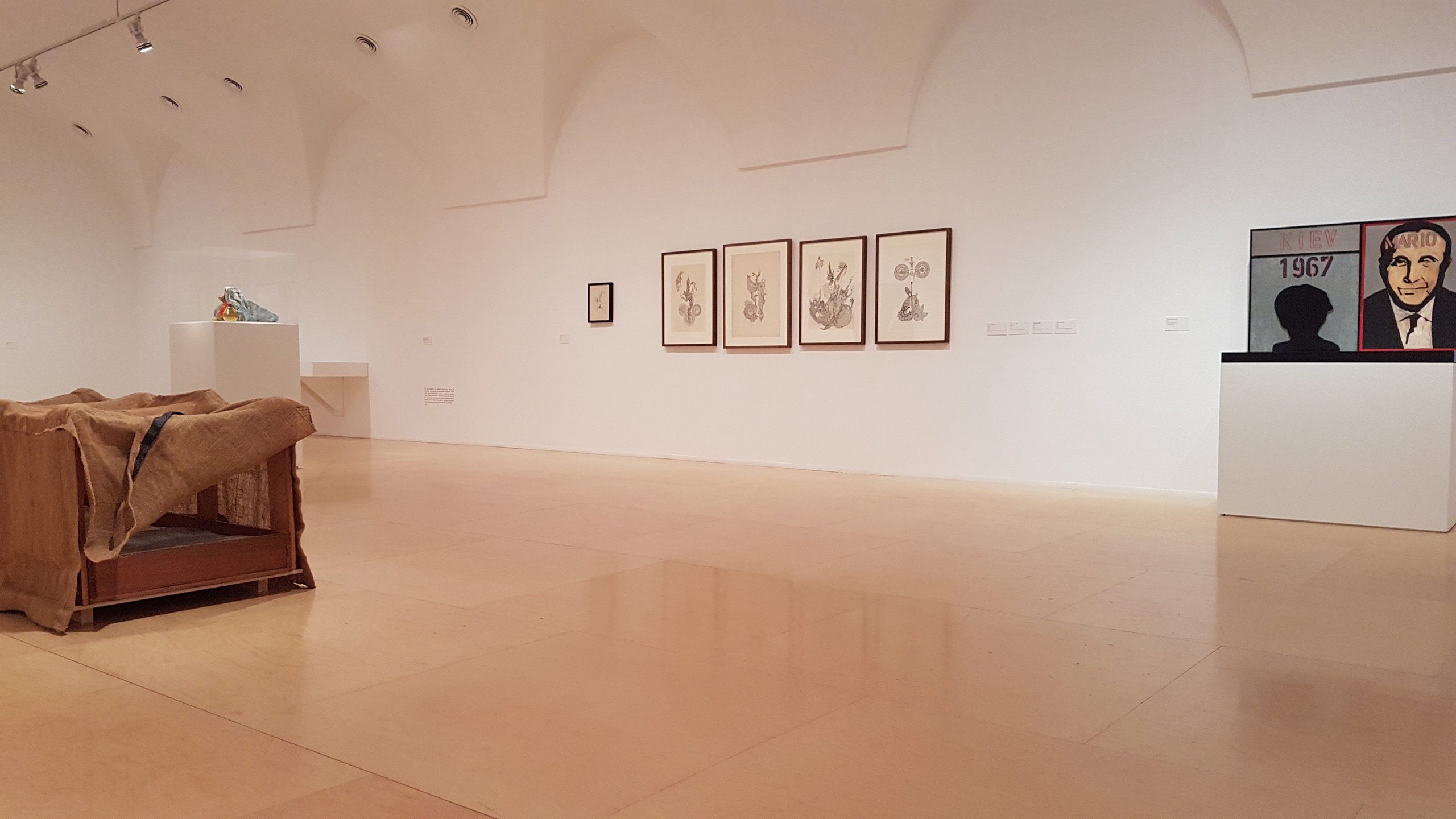
and Michelle Sommer at one of the world's greatest museums,
the Reina Sophia Museum in Madrid.
courtesy Stephen Romano Gallery
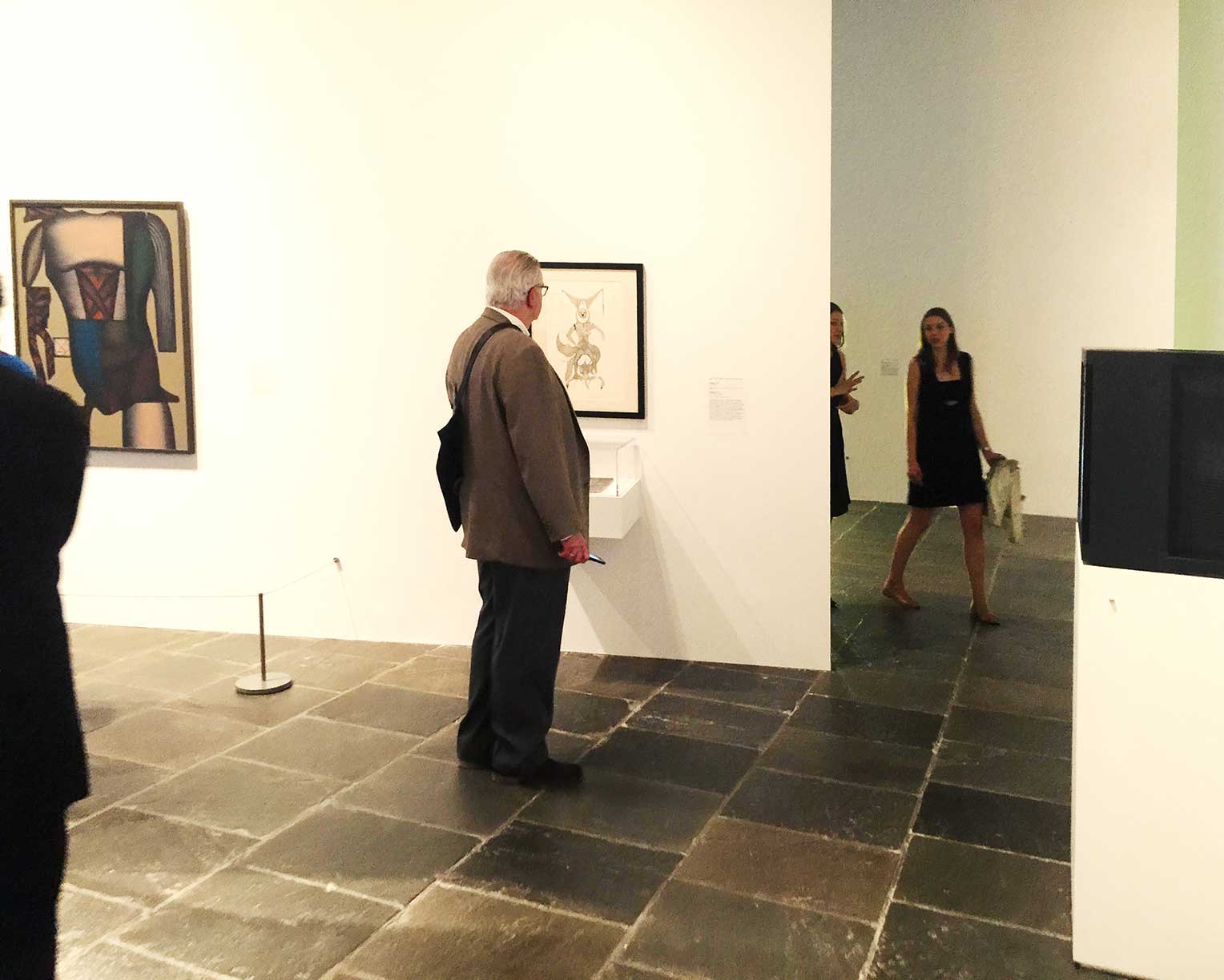
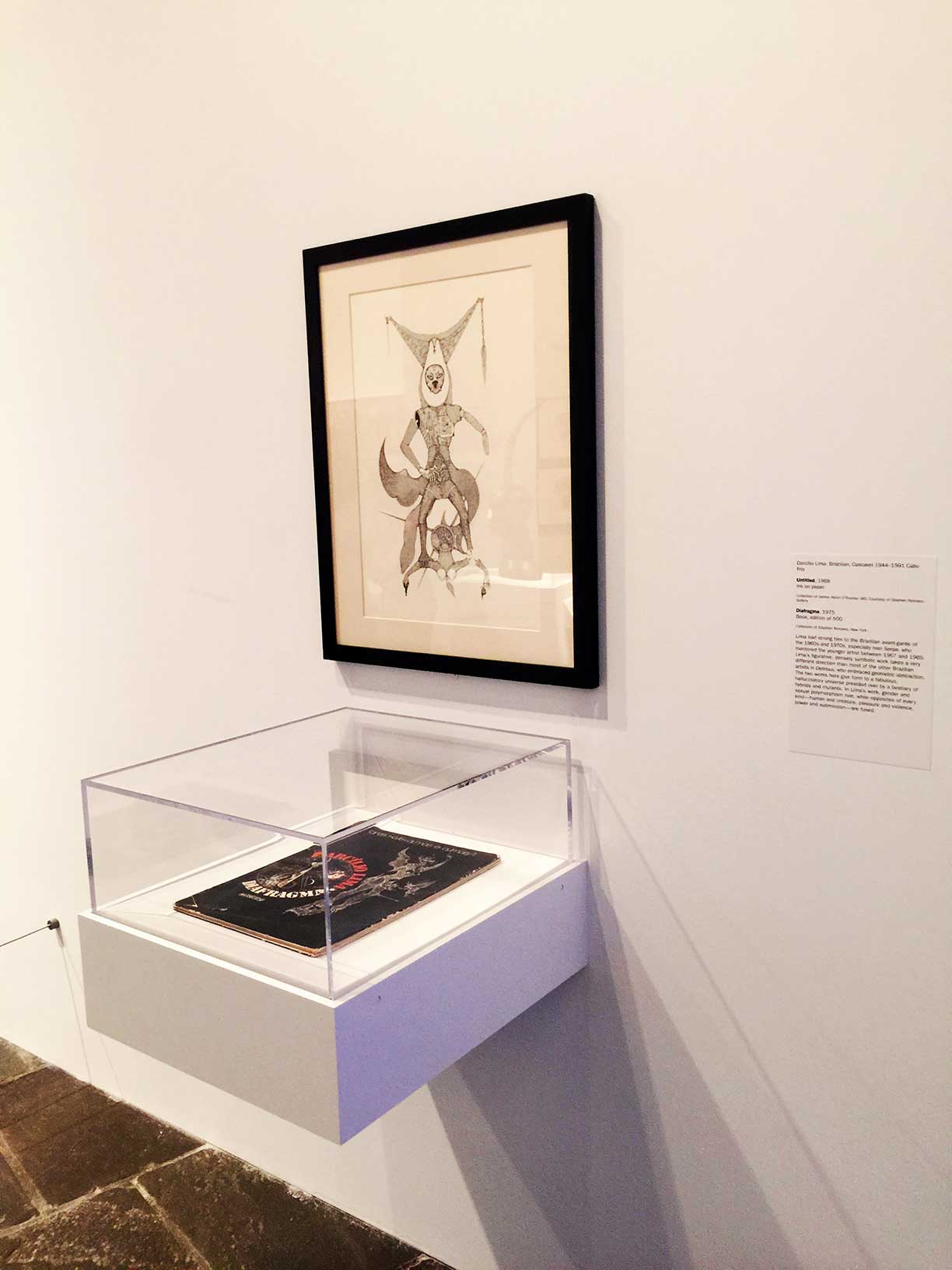


courtesy Stephen Romano Gallery
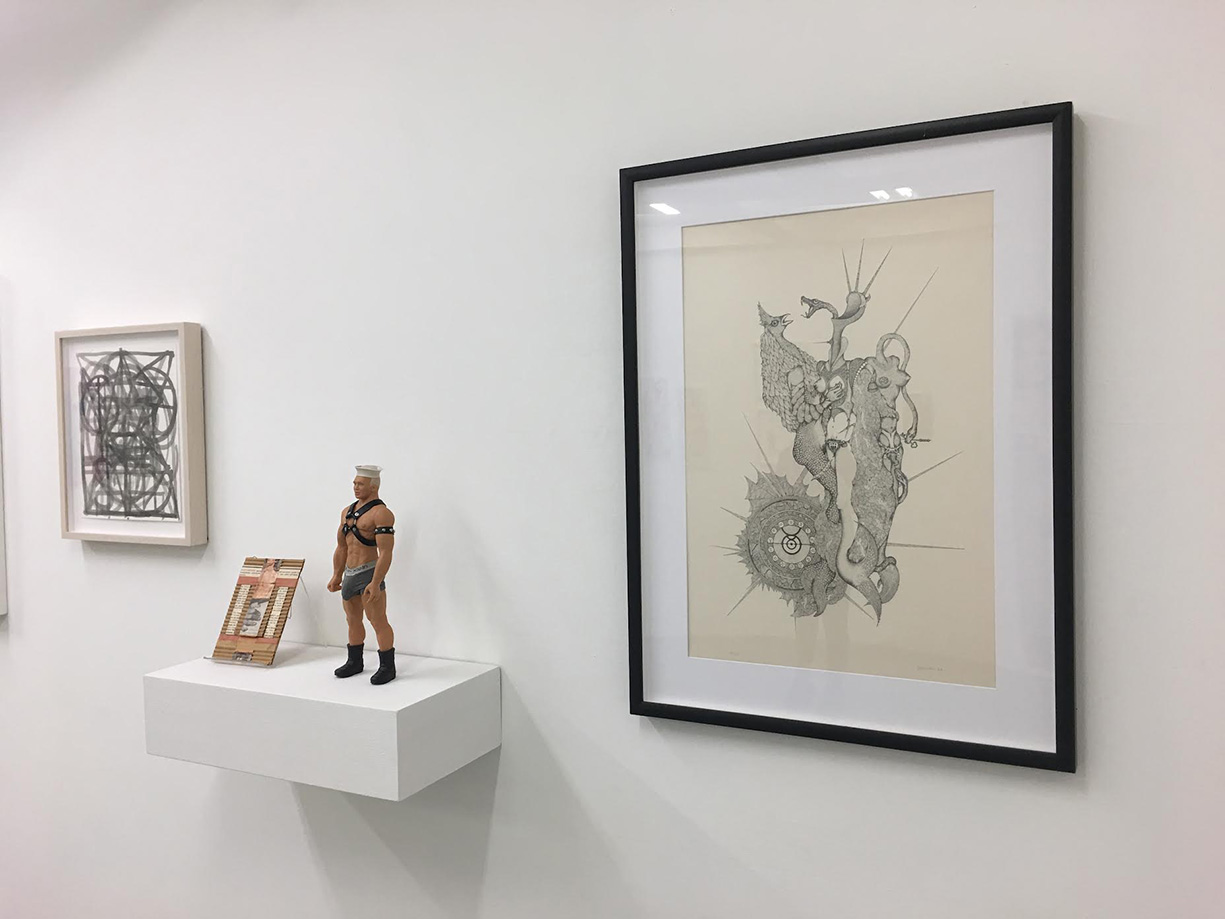
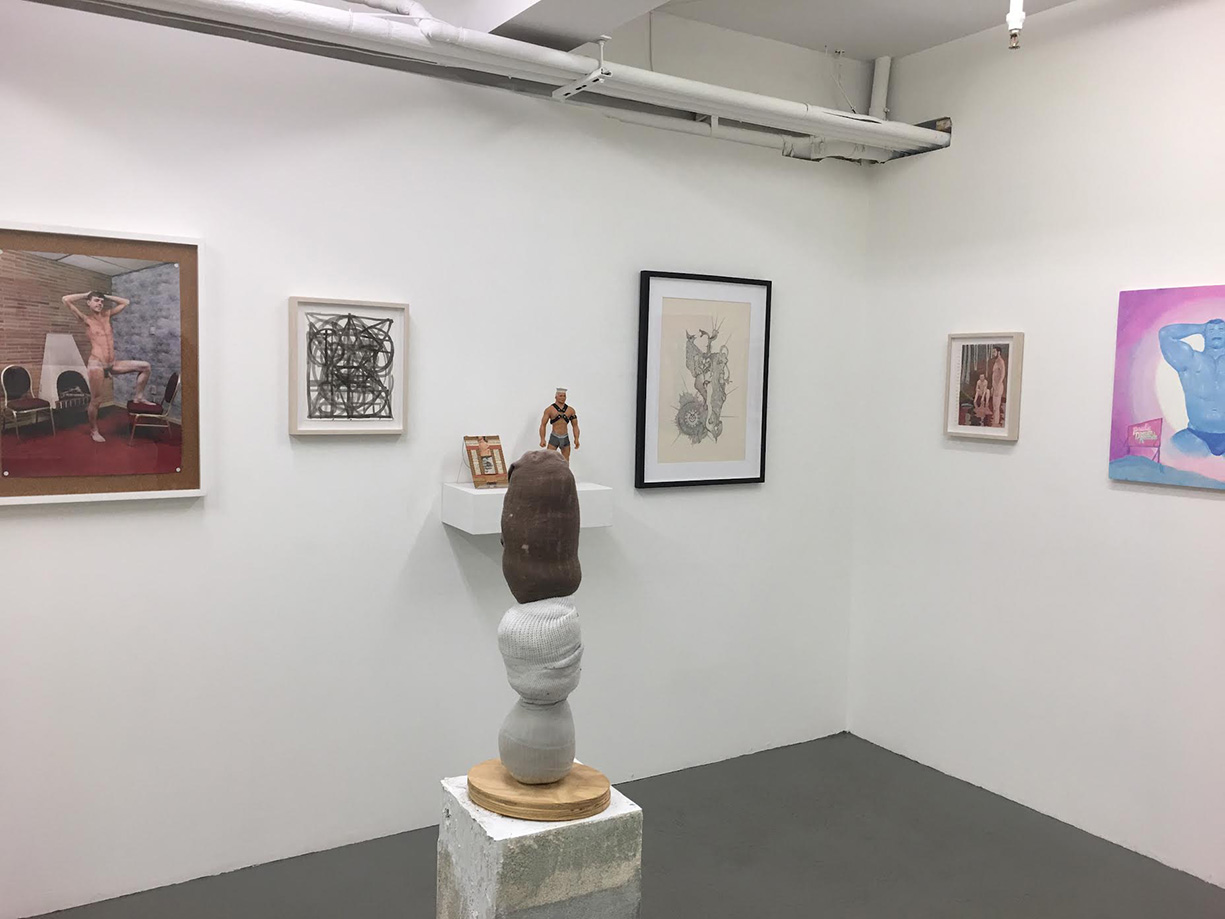
Darcilio Lima at Shelter Gallery NYC "BRAINBOW"
CURATED BY MATTHEW BEDE MURPHY 2021
courtesy Stephen Romano Gallery
WHO WAS DARCILIO LIMA?
courtesy WIDEWALLS.
Darcilio Lima (Darcílio Paula Lima) was a Brazilian painter, designer and writer, born in 1944 in the coastal town of Cascavel in Ceara,
a poor state in the Northeast of Brazil, and died at the age of 47.
This mysterious figure is known as a visionary artist, outsider and one of the leading names in Brazilian Surrealism. His first art exhibit was held
when he was only 10 years old, his friend was Salvador Dali, and he was a prominent figure in the 1960s underground art scene of Rio de Janeiro.
Darcilio Lima is a self-taught artist. In 1957 he moved from his hometown to Rio de Janeiro. He studied science fiction, mythology, religion, Sartre, astrology, philosophy and alchemy. He was a bohemian artist, experimenting with drugs and sexuality. In 1966 he suffered a mental breakdown and ended up in a center for mental health, called the Casa das Palmeires. There he met Ivan Serpa, the prominent artist from Brazil, who mentored him and fostered his talent. Lima was also an apprentice to Marcello Grassmann, who taught him engraving techniques. In 1972 the artist went to Europe upon doing illustrations for the magazine Bizarre, and stayed in France for three years. He befriended Salvador Dali, Moebius and Jodorowsky. Lima went back to Brazil in 1975, where he had a solo exhibition and showed 25 engravings. The exhibition was accompanied by the book Darcílio Lima: Diafragma, published by Etcetera Edições from Rio de Janeiro. The book included reproductions of the engravings. The edition was limited to 500 copies, and one of the copies was featured in the
collection of the MoMA and the Getty Library.
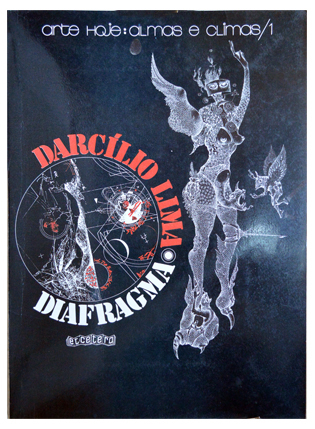
The book gained him a lot of international attention, however, after the book was published the artist just disappeared.
During his life, Lima exhibited his engravings and pen-and-ink drawings in solo exhibitions in Brazil and France, and participated in several group shows in Brazil.
After his death, he had his work displayed in several exhibits and art fairs, such as Pulse New York Art Fair and The Metro Show in New York City.
Most recently, his work was exhibited at Stephen Romano Gallery, New York.
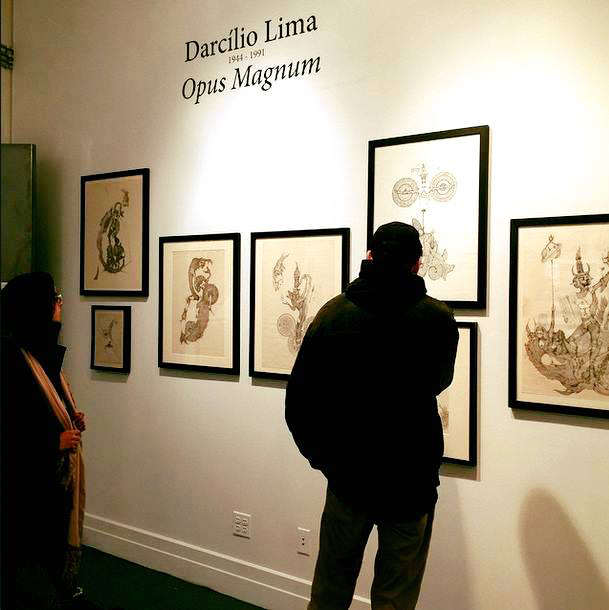
Darcilio exhibition "Opus Magnum" at stephen ROMANO gallery, New York .
In 1967 the artist won the gold medal at the Contemporary Art Salon in Campinas. In the 1970s, his work was featured in Mostra da Gravura Brasileira, the Bienal de São Paulo and the Bienal Nacional.
Editor's note - After his exhibition in 1975 "Diafragma", Darcilio Lima disappeared from the art world and from mainstream society in general. His whereabouts were unknown to any of his peers or associates. It was not until the late 1980's that he was found by a journalist back in the hometown of Cascavel in Ceara where he grew up, but under very different circumstances.
He was now homeless, his hair, clothes and in disorder, unkempt, and speaking in incomprehensible gibberish. He seems to have been neglected altogether, except for the graces of the catholic church who provided him with a dirt floor room at the back of the church where he slept and drew on discarded pieces of paper as well as on the walls themselves. The church had convinced Darcilio that the works he had created at the height of his artistic career were graven, and he thus set out to destroy as much of his art as he could, and in it's place create work of a benign nature. Thankfully, Lima was not able to get his hands on everything and a few examples have survived.
Darcilio Lima fell on his head and died in 1991 in Cabo Frio, Brazil. A tragic end for a visionary artist who did not live very long, but left an amazing legacy to be re-discovered.
COMPLETE OBSCURITY, POSTHUMOUS RECONGNITION
in 2006, Darcilio Lima is included in “Visual Glossolalia” at the Louise Ross Gallery in New York City alongside such notable artists as Minnie Evans, J.B. Murray, Leroy Person, Melvin Way, and Carlo Zinelli. Roberta Smith writes in her July, 2005 review of this exhibition for the New York Times that, “Darcílio Lima (Brazilian, 1944-1991) drew exquisite hybrid creatures worthy of Gustave Moreau that seem guided by delicate numbered diagrams.”
In the same year, his work is included in in an exhibition which is a tribute to the 150th anniversary of the birth of Sigmund Freud, Centro Cultural Banco do Nordeste, Fortaleza, CE.
In 2011, Beate Echols writes, “Darcílio Lima—Artist, Prophet, Time Traveler,” an article on the artists’ life and work, for the Online magazine “Escape into Life.”
Lima, who is all but forgotten by this time, receives new praise and attention throughout the world.
The following year, the works of Darcílio Lima are featured at New York City’s Outsider Art Fair, and are reviewed by Executive Editor of ArtNews magazine Robin Cembalest, who writes: “At Stephen Romano’s booth, we came upon several bizarre (and perverse) etchings by Darcílio Lima, a self-taught Brazilian artist whose hybrid creatures depict a fantastical cosmology that processes the dark excesses of Romanesque through science fiction, mythology, and more.. The engravings depict hybrid creatures engaged in curious, unknowable rituals that seem designed to at once seduce and repel the viewer..” 2013: Darcílio Lima’s works are shown at the Metro Show in New York City alongside Charles Dellschau, William Mortensen, Herman Finney, and Andreas Cellarius’ Harmonia Macrocosmica.
The following year, the works are featured at The Metro Show in New York in January 2012, and an accompanying catalog is published by Stephen Romano Gallery with an essay by the president of the ABCD Art Brut collection in Paris Barbara Safarova. Catalog is available in pdf format.
Darcilio Lima's work is also featured at the PULSE at fair in New York the same year, alongside Henry Darger, Charles Dellschau and William Mortensen.
Darcilio Lima is featured again in 2013 at the Metro Show and the Outsider Art Fair.
In 2015, As well as being featured in the Morbid Anatomy Museum's exhibition "Opus Hypnagogia", Lima's art was featured in what would be his first American solo exhibition, at Stephen Romano Gallery. The exhibition is celebrated by collectors, critics and curators alike, including a major feature on the artist in the Huffington Post:
"Darcilio Lima had his first art show at 10 years old. He was a crucial player in Rio’s hedonistic underground art scene in the 1960s. He spent a significant period of time in the 1970s in Paris, sleeping in a graveyard. Like any legit surrealist, he was friends with Salvador Dali. And, yet, the Brazilian artist’s name remains widely unknown, despite the captivatingly fine lines and hypnotically twisted figures that ooze forth from the darkest depths of his subconscious.
Thankfully, an exhibition entitled “Opus Magnun” at Stephen Romano Gallery in New York City will explore the macabre labyrinths of Lima’s mind, hopefully bringing the artist, who died in 1994, the recognition he’s long deserved."
“Many artists are relegated to obscurity after they die,” curator Stephen Romano explained to The Huffington Post. “Lima’s legacy was dormant for many years as there was no one to perpetuate or to advocate for them. I found three works in an obscure auction several years ago and was completely mesmerized, i felt in some ways he had found me not the other way around.”
“Darcilio Lima was a quintessential ‘outsider artist,’ someone who’s marginalization was at the very core of their art making,” said Romano. “By embracing his own madness as an essential component of his own identity, Lima was extremely courageous about rendering an often frightening truth , often going far past the edge in illustrating what would still be considered 40 years later as taboo. However, by anchoring his art in astonishing technical proficiency, the art of Darcilio Lima, while being the product of a true visionary, has an aura of credibility as well since it is so elaborately and obsessively crafted. The combination of those two elements. visionary subjects and technical mastery, leaves the viewer in no doubt they are in the presence of something rare and special not often seen in this day and age.”
In 1971, the renowned writer R. Beresford Evans wrote:
"Darcilio Lima: Erotic Metaphysician"
In Darcilio Lima an arresting talent for transforming eroticism emerges. It is precious. Despite the near institutionalization of the erotic in the Brazilian art scene Darcilio’s expression remains deeply and appositely personal, while sustaining a dialogue, mythically rich and protean, on, or about, our global metaphysical welfare. The spectator is free to desublimate: to enter a patient role where the artist assumes the mantle of logotherapist. The latitude of the poetic acumen permeating his growths of hybrid images, when weeded to an illustrative technique that commutes between the antenna-like and the cogently incise - but which is always sensitive, meticulous and adamantine, makes for a disturbing experience: excavating ever-deeper across the strata of consciousness so to stir a primordial; purview. It is an awareness to whose brink we are urged either broadside: under the assault of terrible paroxysmal outcries, or elliptically: from the incantatory pull of diabolical sirens.

His configurations resonate out from a Christian and pagan - including its modern analogue of technology - framework into an ever-wider religious orbit that is pregnant with apocalypse. The dialectics of opposites - notably the metaphysical seminals: birth and death, spirit and flesh, rational and autistic, chthonic female and pneumatic male - are experimentally rehearsed in the symbolism proper to alchemy, however much Darcilio, through subsequent pruning and embellishments, personally stamps this language. We witness a serpentine flux. A metamorphosis which restlessly unfolds a gender ambiguity across the hard and the soft, over obscene decay and spectacular fertility, against an incessant interchange of passives (unconscious - virgin - substance - sea - mermaid: bringer of visions) and actives (conscious - impregnator - serpent: despoiler), looks to shoring up - in us - through a mandala idiom that is not only emblematic but mimetic also.
That the patent for these ideas is Jung archetype is a tempting inference, Equally so is an appeal to (say) Norman O. Brown: polymorphous perversity against the disease of sexual - especially genital - differentiation allied to a dionysiac demand that sanctions the immanence of the body (so, too, Luther and Boehme). However it behoves one to await detailed iconographical unpacking, a task not feasible here and difficult anyway if spelling out the banal and pursuing recherché hermeneutics are to be avoided.
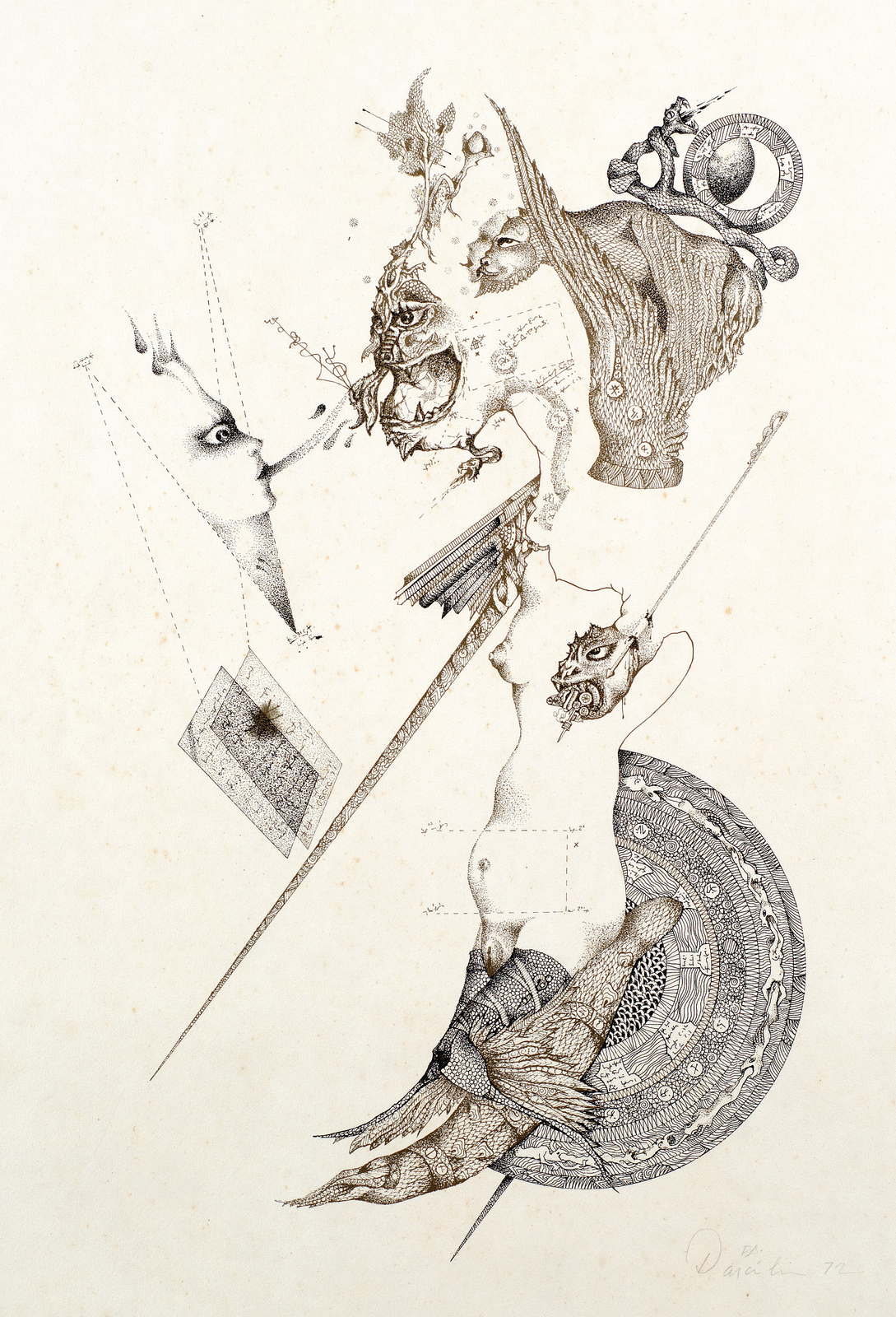
Pace global villages (and where neater have they centrifuged than in the Art World) understanding an oeuvre nurtured separately from the European sensibility risks gratuitous categorization. To locate Darcilio’s erotically informed totems of mutated forms on the map of indigenous surrealism as Walmir Ayala does (‘Art and Artists’, August 1970) is, in one sense, redundant: Breton’s celebrated definition which the Brazilian critics cites is ubiquitously applicable (what cannot be construed as so much ‘psychic automatism’ or as underwriting the ‘omnipotence of dreams’). Less innocuously perhaps: the aegis of surrealism does violence of Darcilio’s conformity to the grammar of alchemical symbolism, to his predilection of organically disciplined excrescences and amputations (variously baroque and gothic), to his distrust of tease in perceptual image, and to his insistence on using only that which lends to discursive plastic representation: to that which is plastically free from lacuna or innuendo. A zeal for discerning historical antecedents might be as well satisfied Erotic Metaphysician by R. Beresford Evans by invoking figures as varied as Blake, Chagall or fin de siécle fantasists. Of course there do obtain a fund of instructive affinities: nevertheless the connections and overlays should be viewed guardedly: only as so many, in Wittgensteins phrase, family resemblances.
A resemblance that demands to be heard out is the genre which forms the main diet of underground graphics. Both Darcilio and illustrators to this rather eclectic weltanschauung are fired by a desire to shake off all that is dogma and repression in our civilization: for all its hindsight sophistication in psychoanalysis and luxury of ideological and social critiques. A belief in the transforming power of astrological agencies, pre-eminently those inherent in the Aquarian era, attests to a common attitude. But such is the cosmetic similarity in their respective use of the body collocations and cut-ups punctuated by oral-rectal-genital interplays that canonisation of Darcilio by the underground would seem to pose a real threat. This does not augur favorably: for the best interests of the artist or of erotica in general.
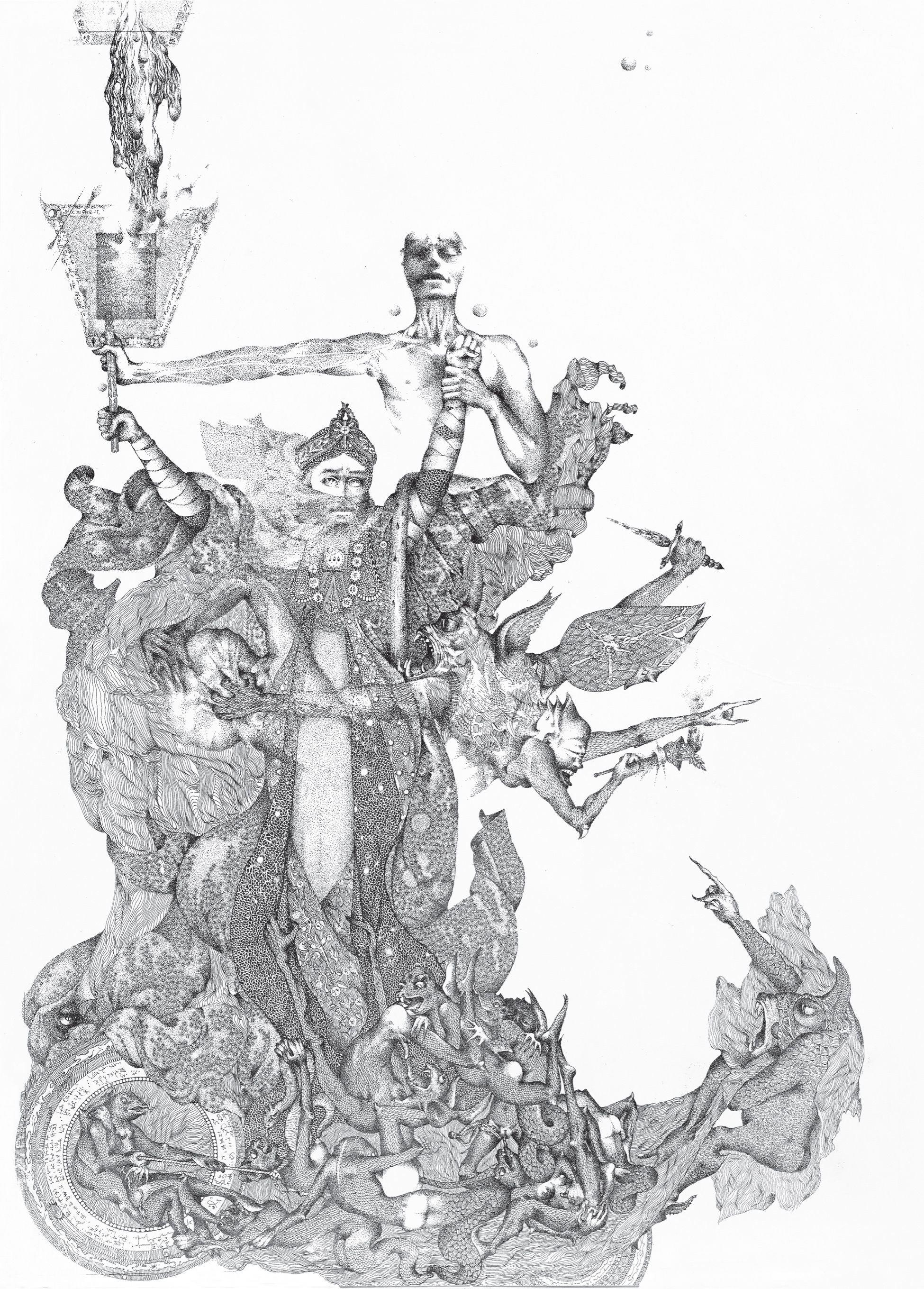
Unhappily at this juncture some elitism intrudes - unavoidably. To be sure, as is the case with most human enterprises, greatly diverging qualities are to be had. But much of the putative erotic material of (say) The Oz ultra trendy poster variety deteriorates into an insipid stylisation: mere decoration. Oppositely, Darcilio avoids the pitfalls of reciped caprice or plain imbroglio. A probing resourcefulness and critical ingenuity for integrating new issues of delineation with his chosen style are inimical to this precocious decadence. An eroticism in which mediocrity triumphs, which stands on mechanical resolutions, is as allegorically bankrupt as (it) is a commodity in the pornshop. Where innovation becomes so much cliched profanation, surrogate erotica is the inevitable outcome (and the anaesthetic of the hip “cool” makes for a bizarre pornokitsch?).
It should go without saying that the erotic dimension of (say) “The Accusation” is well insulated against such a fate. So microcosmic of the collective base fears and aspirations of mankind is the sexual motif that any hiving off of its profound energy into some well-trodden cul de sac of local titivation or some voyeuristic circus becomes, where not impertinent, vainly arduous. Force lines of psychic and religious allegory accelerate under the anode of Darcilio’s conceits, extravagances and mythically dense fantasies, gaining a momentum such as to promise a panoramic prospect of the metaphysical landscapes of our time. And erotics assume a democratic daedalian invitation forged in the alchemical laboratory.
DARCILIO LIMA ENTERS THE PARTHENON OF VISIONARY MASTERS
In 2016 Lima's works were featured in several group exhibitions, including "Materia Prima" At BLAM Gallery in New York, alongside visionary masters such as William Mortensen, Jacob Bohme, Charles Dellschau, Olga Fröbe-Kapteyn, A. Fiorello, William Blayney as well as renowned contemporary artists such as Barry William Hale, Colin Christian, Hanna Juan, Alexis Karl, Ken Weber, A.W. Sommers, Samuel D Gliner, Delarosa De La Cruz, Linnea Strid, Lena Viddo, Damien Michaels, Jaya Suberg, Charlotte Rodgers, Lukasz Grochocki, Sarah Zar, Orryelle Defenestrate, Inge Vandormael, Travis Lawrence, Judith Vergara García, Lori Field, among many others.
2017 was the year Darcilio Lima finally got his day in the sun. His art was featured prominently at the 25th Outsider Art Fair in New York.
Shortly after in March, his art was included in the Scope contemporary art fair in New York where it was seen by well over 10,000 people.
In April, five works by Darcilio Lima were included in the exhibition "Mário Pedrosa" On the Affective Nature of Form" curated by Gabriel Pérez-Barreiro and Michelle Sommer at one of the world's greatest museums, the Reina Sophia Museum in Madrid, and reproduced in the accompanying catalog.
The odyssey the art of Darcilio Lima has taken, from the first solo exhibition of a ten year old boy at his school to the world's greatest museums, is the story of how an artist from the lowest echelons of economic destitution prioritized his art making as a source of empowerment, and eventually found his way in world of chaos into the Parthenon of great art.
from the 1969 text by Mario Pedrosa
(click to enlrage)
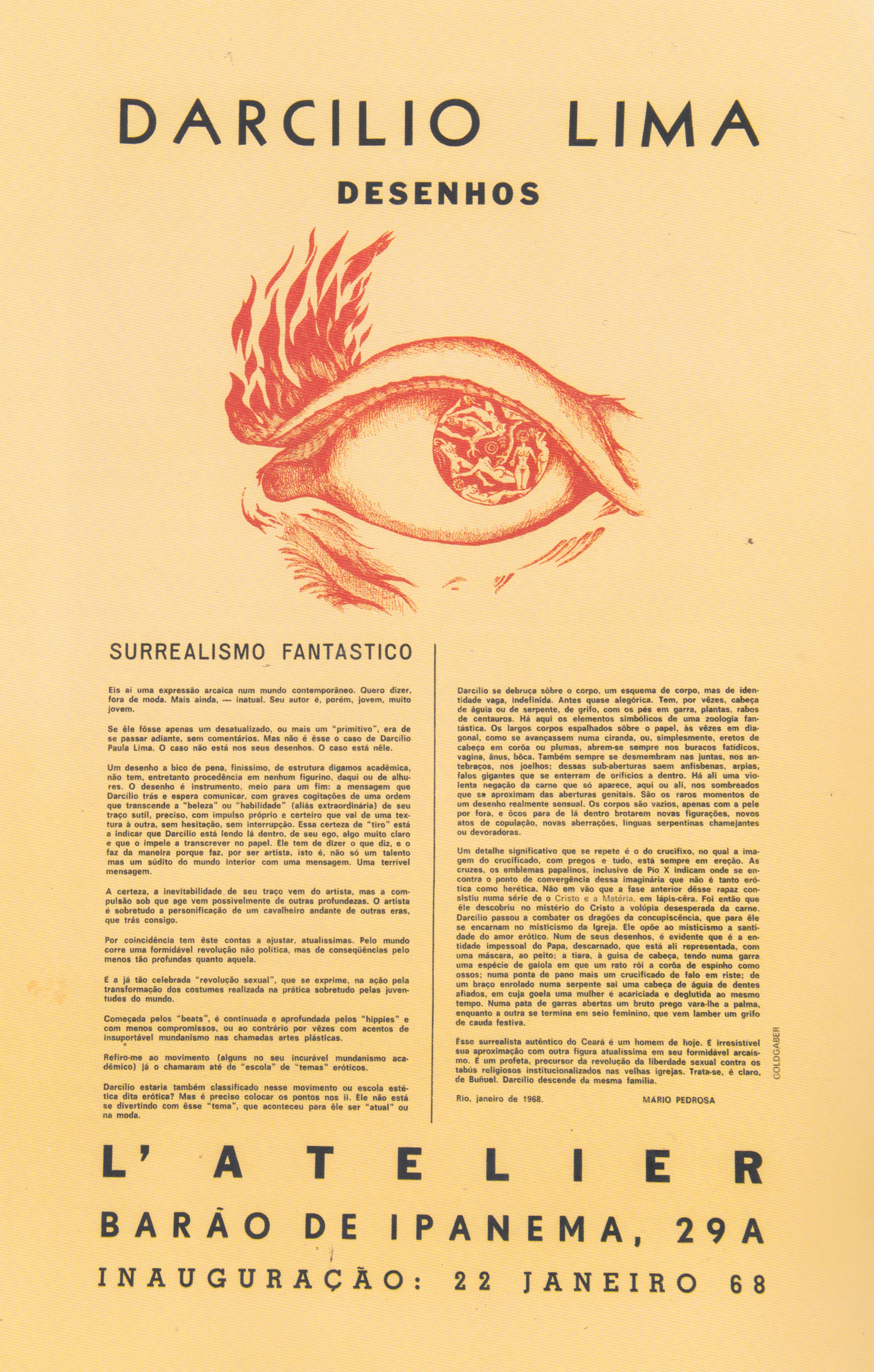
FANTASTIC SURREALISM
Here is an archaic expression in a contemporary world, I mean, out of fashion. More so, — out of date. Its author is, however, young, very young.
If Me were just an outdated one, or another "primitive", it would be passed on without comment. But that was not the case with Darcilio Paula Lima. The case is not in your drawings. The case is there.
A fine pen-and-ink drawing, with an academic structure, however, has no origin in any costume, here or elsewhere. Drawing is an instrument, a means to an end: the message that Darcilio brings and hopes to communicate, with serious thoughts of an order that transcends the "beauty" or "skill" (in fact extraordinary) of his subtle, precise trait, with its own impulse and that goes from one texture to another, without hesitation, without interruption. This certainty of "shot" is indicating that Darcilio is reading inside, from his ego, something very clear and that impels him to transcribe on paper. Lie has to say what he says, and he does it the way he does, because he is an artist, that is, not just a talent but a subject of the Inner world with a message. A terrible message.
The certainty, the inevitability of his stroke comes from the artist, but the compulsion under which he acts possibly comes from other depths. The artist is above all the personification of a gentleman errant from other eras, which he brings with him. Coincidentally, he has a very up-to-date score to settle. A formidable revolution is taking place around the world, not political, but with consequences at least as profound as that one. the already much celebrated "sexual revolution", which is expressed in the action of the transformation of customs carried out in practice above all by the youth of the world. Started by the "beats", it is continued and deepened by the "hippies" and with fewer commitments, or on the contrary, sometimes with accents of unbearable worldliness in the so-called plastic arts.
I am referring to the movement (some in their incurable academic worldliness) have even called it a "school" of erotic "themes". Would Darcílio also be classified in this so-called erotic aesthetic movement or school? But it is necessary to put the dots in the ii. He's not having fun with this "theme", which happened to be "current" or trendy.
Darcilio focuses on the body, a schema of the body, but with a vague, undefined identity. Before almost allegorical. It has, at times, caie“-:a of iligui4 or of serpent, of griffin. with claw feet, plants, centaur rabc,s. There are here the symbolic elements of a fantastic zoology. The large bodies spread out on the paper, sometimes diagonally, as if they were advancing in a ciranda, or, subplesmep-ite, erect, bald in choruses or feathers, always open into the fateful holes, vagina, nude, mouth. They are also always dismembered in the joints, in the forearms, in the knees; from these sub-openings come amphisbaenians, harpy eagles, giant phalluses that burrow through holes. There is a violent negation of the flesh that only appears, here or there, in the shadings that approach the blindfolds. These are the rare moments of a really sensual drawing. The bodies are empty, with only the skin on the outside, and hollow pana de II inside sprout new tigurat and 5, new acts of copufacao, new aberrations, serpentine tongues flaming or devouring.
A significant detail that is repeated is that of the crucifix, in which the image of the crucified one, nails and all, is always in erection. The crosses, the papal emblems, including those of Pius X, indicate where I am. against the point of convergence of this imaginary that is not so much erotic as heretical. Not in vain that this young man's previous phase consisted of a series of Christ and Matter, in pencil wax. It was then that he discovered in the mystery of the Christ the desperate voluptuousness of the flesh, Darcilio began to fight the dragons of concocence, which for him are incarnated in the mysticism of the Church. He opposes to mysticism the sanctity of erotic love. In one of his drawings, it is evident that it is the impersonal entity of the Pope, emaciated, that is represented there, with a mask, on his chest. the tiara, the headdress, having in a claw a kind of cage in which a mouse gnaws the thorn rope like bones; on a point of cloth, another crucified with the phallus in the air: from an arm wrapped around a serpent comes an eagle's head with sharp teeth, in whose throat a woman is caressed and swallowed at the same time. In one paw with open claws, a crude nail pierces its palm, while the other ends with the 4t female breast, which comes to lick a griffin with a festive tail.
This authentic surrealist from Ceara is a man of today. His approach to another very current figure in his formidable archaism is irresistible. He is a prophet, a precursor of the sexual freedom revolution against institutionalized religious taboos in the old churches. It is, of course, Buhuet. Darcilio descends from the same family,
River.
January 1968 MÁRIO PEDROSA
LI MONTEIRO, PATRON SAINT OF OUR BELOVED DARCILIO
"We talked through codes. …But I always understood"
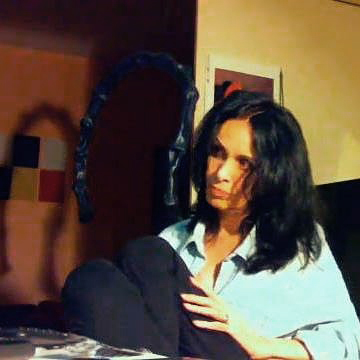
Li Monteiro, whom was like a sister to Darcilio Lima and has made a herculean effort to perpetuate the artist's legacy says:
"I met Darcílio Lima from the beginning of his career and I organized many of their exhibitions. He was accommodated at my house sometimes where I lived with my children in the last year of his life because I was the closest person as if I was his sister and I gave him the possible support."
"We talked through codes. He was worried talking directly…But I always understood his codes. We use a special language to communicate."
"I was with him in Paris when he exposed with Salvador Dali and Leonor Fini. In the same phase he approached Joan Baez, and he went to Scotland while I was living when we were in Rio de Janeiro and I always knew what happened with him."
"He came back to Brazil for a disease of his father that died and he passed a very difficult phase. In this retrospective that I organized, with 5 videos of some Brazilian “videoastas” on his life and work that I accompanied parts, gave a simple deposition on him in video that I have the copy here. A lot of histories happened in this final stage. Little by little I will try to scanner and order his material telling you more possible details."
"Do you know why people don´t want talk about Darcílio Lima?...His life was full of ups and downs…and there are few people that is a friend when something strange is happening. That´s is life. For me, a part from all his difficulties, he never gave me any trouble even when he was in my house for three times that he needed, I was someone that he trusted and preserved."
"And another thing was very strange during his last days…he asked me a favor…asked me to keep his agenda, passport telling me that after I will understand soon. I said OK…but I felt that he knew something will happen (I don´t know why) and I said OK!"
"Two days later, my good friend in Busios (a beach near here) called me telling me that he had a strange accident and was in the Hospital. I took a taxi but when I arrived there he was dead. We organized his funeral there in Busios and I put a note in a good journal to tell his family and friends that he died. I gave all his documents to his brother one month later including his self-portrait that didn't´t belong to me, did this retrospective and I don´t know more what happened.”
“Darcílio had very mysterious life and also his death! But he was and is a very special friend and artist for me."
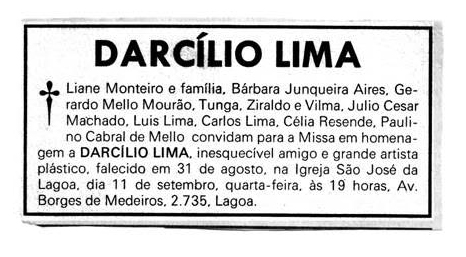
The obituary of Darcilio Lima 1991. courtesy LI MONTEIRO
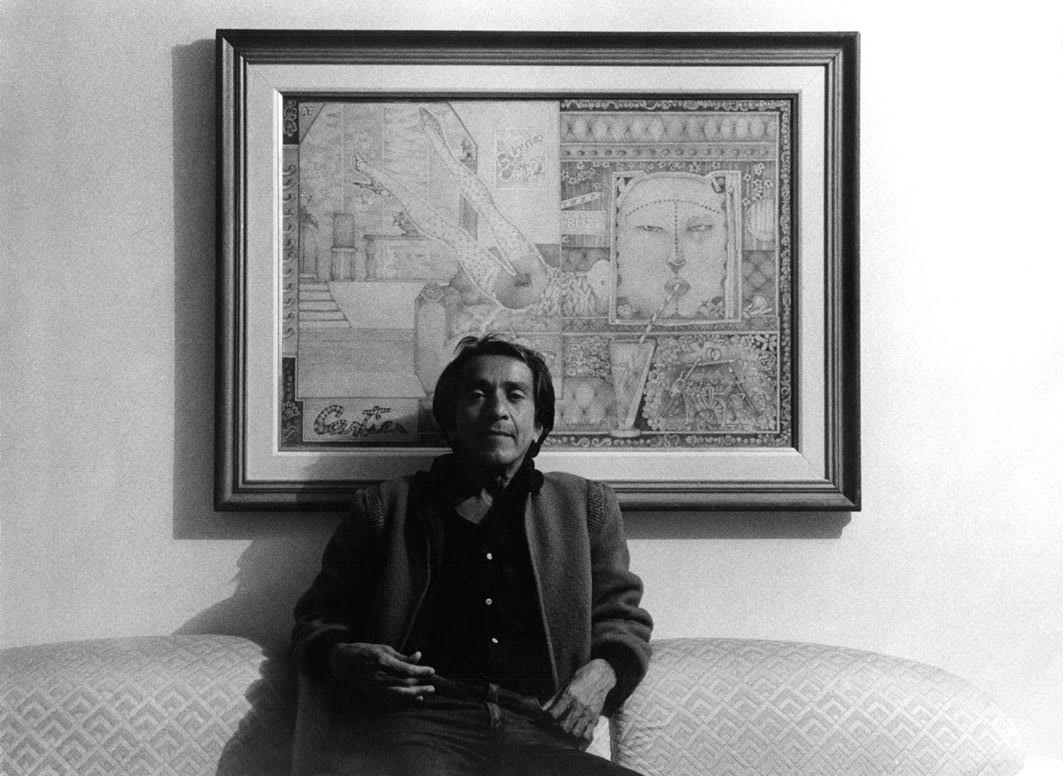
Darcilio Lima 1944 - 1991. courtesy LI MONTEIRO
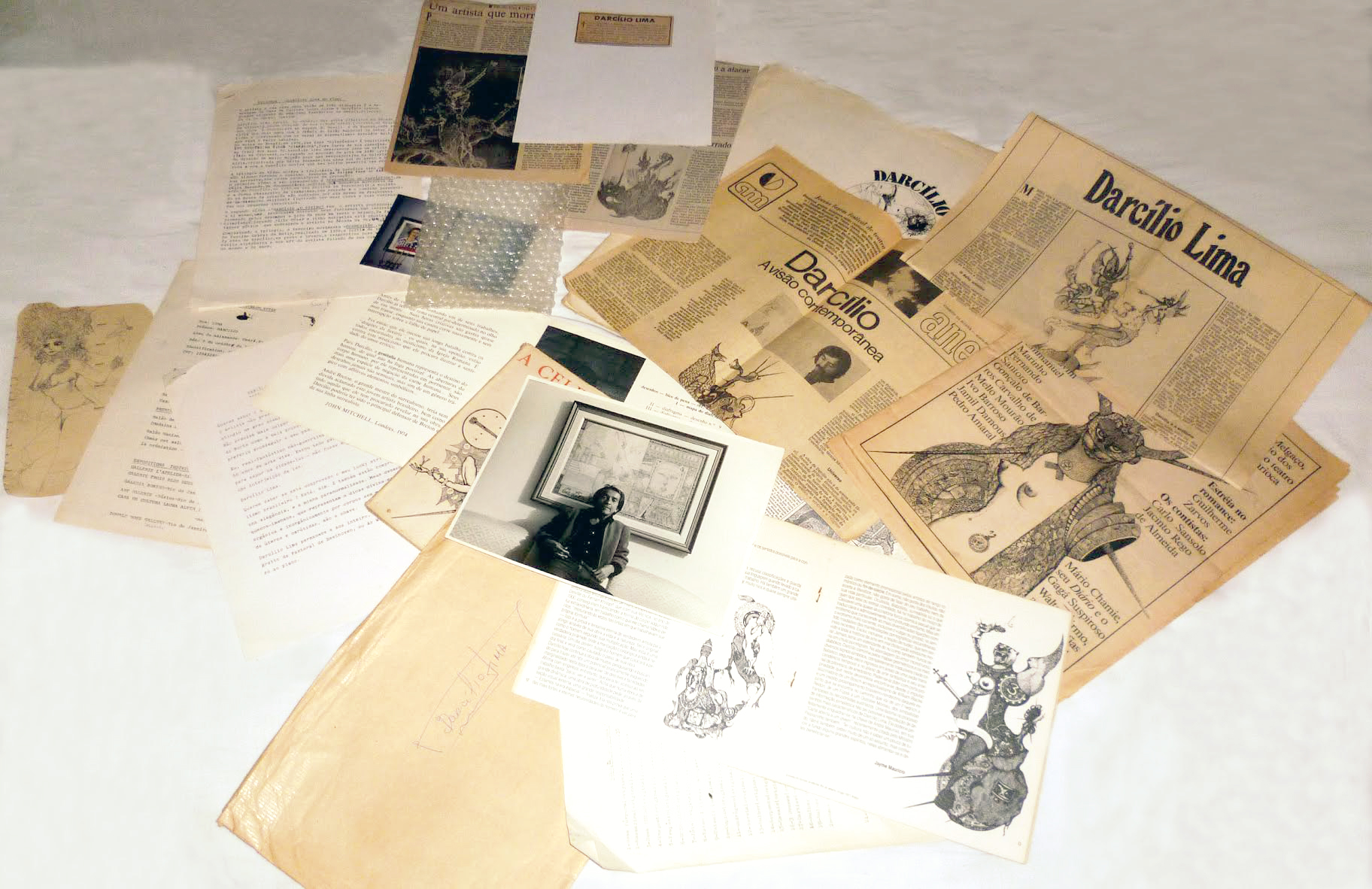
Li Monteiro's archive of Darcilio Lima ephemera.
Darcílio Lima’s Opus Magnum by Barbara Safarova
“When we say things openly in fact, we do not say anything. But when our language is encrypted and put in images, we cover the truth.” Rosarium philosophorum, 1550
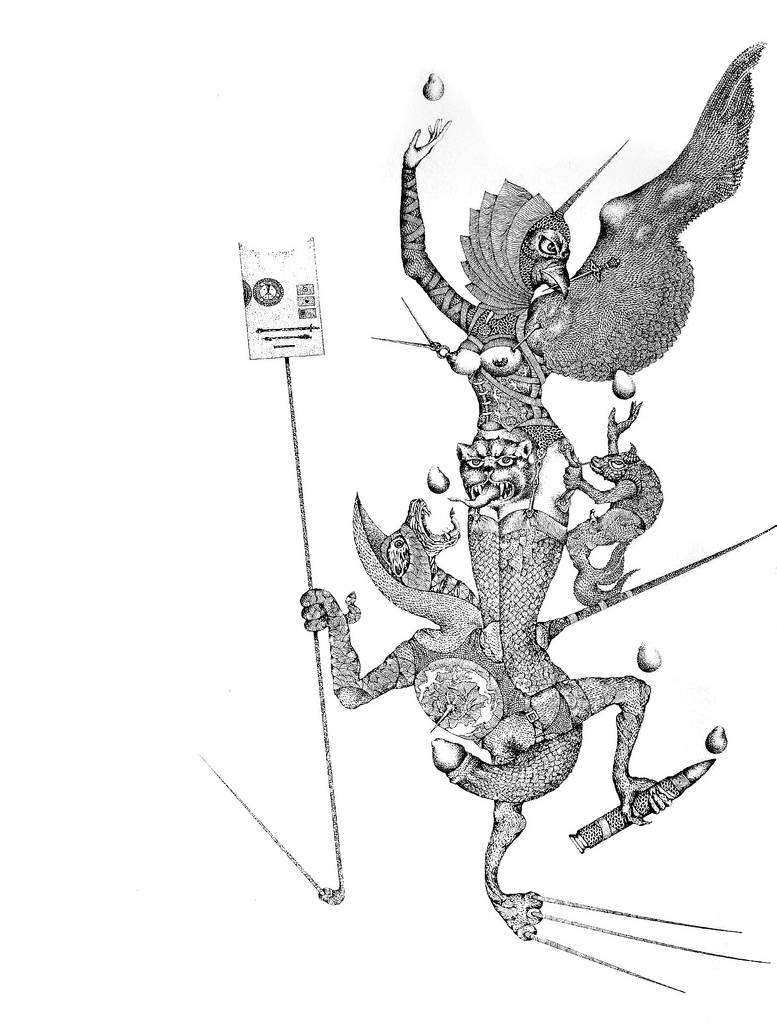
In the first half of the twentieth century the Surrealist movement accomplished in the arts what thinkers like Carl Gustav Jung or Gaston Bachelard achieved at the theoretical level: the rehabilitation of image in connection with mythical thinking. Gradually, image became not only another way of seeing the world, but also a true epiphany of the being of things, a means of knowledge — a secret number of human destiny.
If at first sight the Brazilian artist Darcílio Lima belongs to the Surrealist aesthetic, he seems first of all a true spiritual brother of the great alchemists of the Renaissance. Through their Art, in search of the Opus Magnum (1), they aimed to heal the sick body of the world by creating a new order. According to the Greek pre-Socratic philosopher Empedocles, all life is a movement born out of the tension between the bipolar forces of love and hate. These forces correspond in the Opus Magnum to the successive operations of solution and coagulation, dissolution and fixation, distillation and condensation, systole and diastole, the “yes and no in all things.” (2) In Arabic alchemy there are also two bipolar agents—sulfur and philosophical mercury, the sun and the moon, the white wife and the red husband.
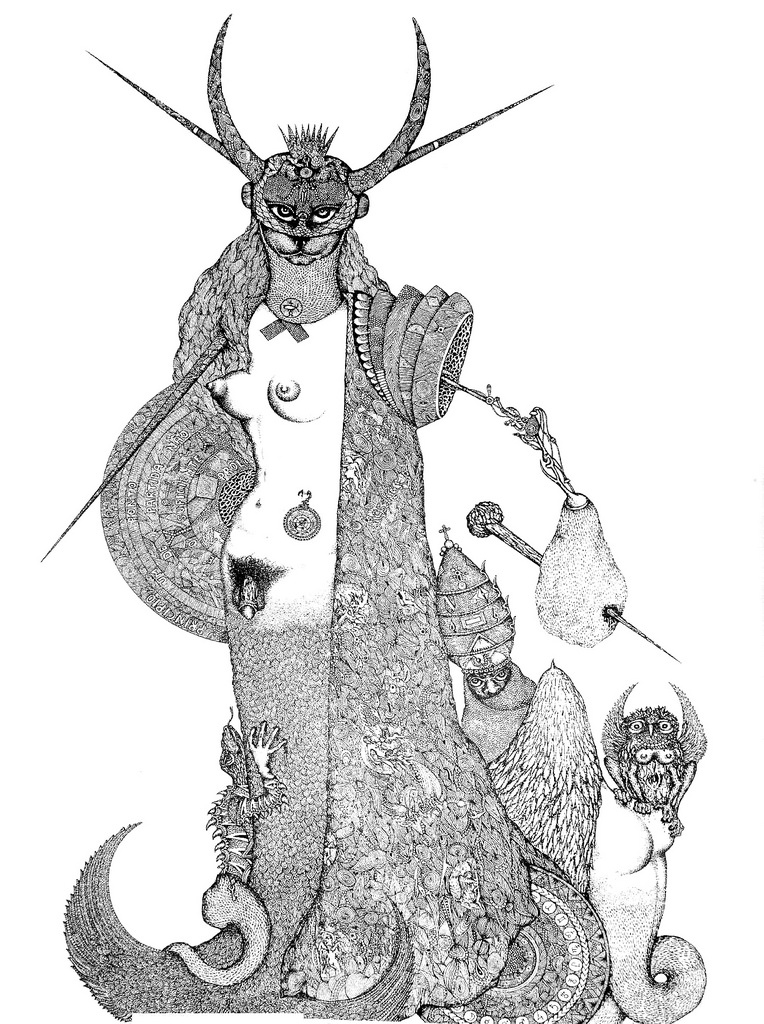
The high point of the “Great Work” is the conjunction: the union of masculine and feminine principles—the igneous spirit and aqueous material—at the wedding of heaven and earth. And the unbreakable product of this cosmic coupling is the Philosopher’s stone symbolizing perfection, lapis—“the son of the red sun”—or Christ-Lapis: “After much suffering and great pain / I have risen, clarified and spotless.” (3)
We could conclude that the eroticism and sexuality Lima shows in his images—and that leads to the meeting of two opposite aspects—functions not only as a highly personal version of an alchemic treatise, but above all as a critique of false moral doctrines and religious dogmatism, instruments of sexual repression. Behind the violence of Lima’s images we can perhaps also discover a highly intelligent and insightful critique of the materialist and mechanical worldview, the disastrous repercussions of which have been felt throughout the twentieth century until today.
In an attempt to grasp the meaning of Lima’s artistic production—and in the absence of other artist’s testimonies other than those left in his work—one can begin by identifying certain esoteric symbols. In his work, we often perceive the triangle—the symbol of fire— the circle and the dot, with the circle representing eternity, and the dot the concentration of time in one single moment , the snake, (4) the signs of the Zodiac, and the eye of the awakening, among others. Lima’s secret universe is designed as a kind of cipher, a mysterious writing, which also features in some of his images.
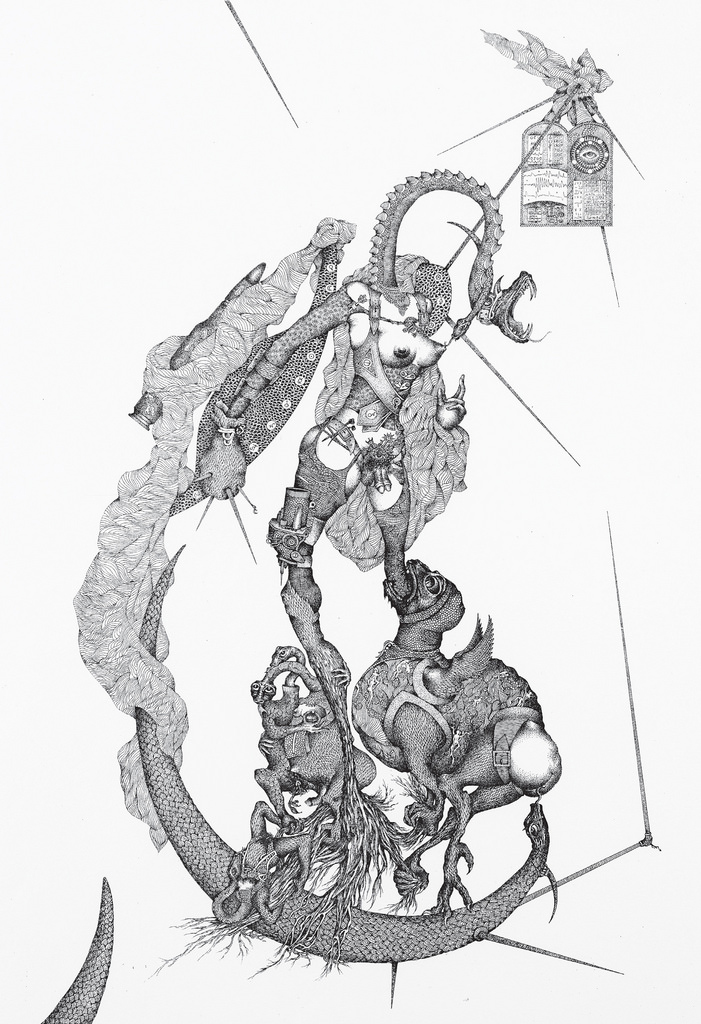
We are reminded of signs that appear on the scales of a turtle, and that would have been the ancient Chinese model for their language’s first characters. Is the purpose of this enigmatic writing to confer a sacred power to language? There are also other references, more aesthetic than esoteric. The hand that pinches the breast of Lima’s polymorphic beings again points to the artist’s double affiliation: on one side the late Renaissance School of Fontainebleau (the portrait of Gabrielle d’Estrées and One of Her Sisters, 1594) as a possible source of inspiration, on the other, certain works of his fellow Surrealists. We can recall, for example Hans Bellmer’s Games of the Doll (5) (1949)—the hand-colored black-and-white photographs of a tied, decapitated female body—or Metamorphosis of Narcissus, by Salvador Dali (1937)
In his poetic essay Arcane 17, André Breton emphasizes the quadruple nature of the fairy Melusine, a Surreal figure par excellence. According to Philippe Walter, this marine fairy from the other world, holder of exceptional knowledge, mistress of war and fate, is a beautiful Surreal emblem provided that it is understood she is a figure of the imaginal—that is, “representations which have the property of being autonomous as objects, while putting us in the presence of shapes or patterns without equivalent in experience.” (6) This hybrid woman from the other world is simultaneously a snake, a fish and a bird. Melusine participates in these creatures’ respective crucial elements—earth, water, and air—as their direct emanation. Lima shows us her monstrous nature—the figure lacks an essential element of the human anatomy. The head is often replaced by that of a dragon. Some of her members are enlarged, others are absent. She is characterized by an all-powerful animality, voracity, the presence of double sex. Her bisexuality is related to very specific reproduction—conception by mouth. Her fishtail links her to the world of water and denotes her initiatory knowledge. This Siren has sometimes other feet, which may also function as an allusion to the tripod of the cauldron found on Lima’s images, part of an initiation ritual unfolding before our eyes.
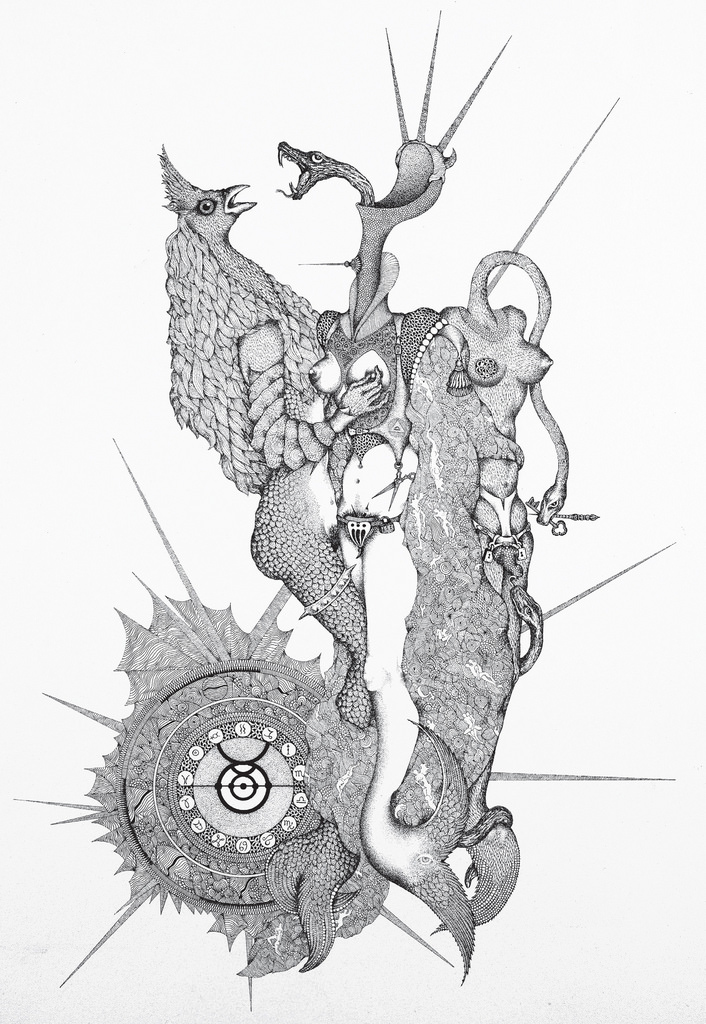
The divinatory power of this androgynous being is more than just anticipating the future. It is as if to say something could provoke the destiny, produce the event itself. This may be one of the essential qualities that the monstrous fairy Melusine shares with the artist. For Lima, to draw is to trace a sacred space—to avoid being devoured? —to ward off the invisible. His gesture of disseminating hermetic symbols by association becomes an operative phenomenon similar to geomancy. It is as if it is his way of accomplishing a process the aim of which is the transmutation of his own self.
The German Christian mystic and theologian Jakob Böhme (1575-1624) was the first to conceive the life of the cosmos as a passionate struggle, a perpetual genesis: “I recognized, I saw the three worlds in me...and I saw the good and bad in everything and how the one flows from the other...I saw chaos where everything lay helter-skelter.” (7) Self-reproduction, self-perpetuating, self-healing of the body to the point of re-organizing it—in this way, through his work, the artist becomes an omnipotent creator. By facing his own reflection in the void, he rises from the ashes. By the creation of new links between hypertrophied organs, and multiple arms and limbs, Lima invents a new cosmogony. The alchemist’s Art and artistic creation overlap without any possibility of separation: the crown of perfection symbolizes the ultimate completion.
1. The Opus Magnum: the “Great Work” starts from a mysterious material called materia prima, in which the isolated parts are totally opposed, then gradually integrated to achieve the state of perfect harmony known as the Philosopher’s Stone or lapis philosophorum.
2. German Christian mystic and theologian Jakob Böhme (1575-1624).
3. Rosarium philosophorum, 1550.
4. According to the mystics a powerful king of nature who has the capacity to heal the entire world, like a saline balm.
5. Hans Bellmer, Les Jeux de la Poupée, Paris, Les Editions premières, 1949.
6. Philippe Water, La fée Mélusine. Le serpent et l’oiseau, Paris, Editions Imago, 2008, p. 207.
7. Jakob Böhme, quoted in Alexander Roob, Le musée hermétique : Alchimie et mystique, Taschen, 2011 (original edition Benedikt Taschen Verlag, 1997).
